You are currently viewing a beta version of our website. If you spot anything unusual, kindly let us know.
Preprint
Article
Enhancing Communication Efficiency and Training Time Uniformity in Federated Learning through Multi-Branch Networks and the Oort Algorithm
Altmetrics
Downloads
83
Views
20
Comments
0
A peer-reviewed article of this preprint also exists.
This version is not peer-reviewed
Abstract
In this study, we present a federated learning approach that combines a multi-branch network and the Oort client selection algorithm to improve the performance of federated learning systems. This method successfully addresses the significant issue of non-iid data, a challenge not adequately tackled by the commonly used MFedAvg method. Additionally, one of the key innovations of this research is the introduction of uniformity, a metric that quantifies the disparity in training time amongst participants in a federated learning setup. This novel concept not only aids in identifying stragglers but also provides valuable insights into assessing the fairness and efficiency of the system. Experimental results underscore the merits of the integrated multi-branch network with the Oort client selection algorithm and highlight the crucial role of uniformity in designing and evaluating federated learning systems.
Keywords:
Subject: Computer Science and Mathematics - Artificial Intelligence and Machine Learning
1. Introduction
Federated learning (FL) [1] has emerged as a powerful approach for training machine learning models on decentralized data without compromising data privacy. It allows multiple clients to collaboratively train a shared global model while keeping their data locally. This distributed learning paradigm has gained significant attention and has been applied to various domains, including healthcare, finance, and the Internet of Things (IoT).
The primary objective of federated learning is to improve communication efficiency and ensure uniform training times among clients; however, the heterogeneity of data and systems in federated learning challenges client selection and training processes. Selecting appropriate clients to participate in training becomes crucial to achieving accurate and efficient model updates.
In this context, the Oort algorithm has been proposed as a client selection method that considers the heterogeneity of data and systems. However, implementing the Oort algorithm (detailed in Section 3.3) has revealed temporal discrepancies in training and communication, leading to inefficient federated learning.
We propose integrating the Multi-Branch Network (MBN) into the existing Oort architecture to address this issue and enhance communication efficiency and training uniformity. The MBN construction is inspired by BranchyNet [2] and Triplewins [3], where additional branch classifiers are incorporated at equidistant points within a given neural network. This modification allows for model averaging and improved performance without needing multiple convolutional layers in each branch.
Furthermore, we introduce a Model Distributor component to allocate different model branches to clients based on their computational capabilities and communication bandwidth. This clustering-based approach ensures that clients receive models tailored to their specific training requirements, optimizing the effectiveness and efficiency of the federated learning process.
This work presents the construction of the MBN and the Model Distributor in detail. We evaluate the performance of our proposed method on benchmark datasets, including CIFAR-10 and FEMNIST, using the ResNet34 model and the MBN. We measure the training time to achieve specific accuracy levels and the number of rounds required to reach the desired performance. Additionally, we analyze the uniformity of the training process and investigate the impact of different hyperparameters.
The rest of this paper is organized as follows: Section 2 provides background information on federated learning and MBN. Section 3 explores the related work in federated learning. Section 4 describes the construction of the MBN and the Model Distributor. Section 5 presents the experimental results and discusses the findings. Finally, Section 6 concludes the thesis and outlines potential directions for future research.
2. Preliminary
2.1. Federated Learning
Federated Learning has emerged as a promising approach in machine learning, enabling decentralized training while addressing privacy and data ownership concerns. The Federated Averaging (FedAvg) algorithm proposed by McMahan et al. [1] is widely used for global aggregation in FL.
FL leverages the power of local devices such as smartphones and tablets to perform model training while a central server aggregates the locally computed updates [4]. This distribution of the learning process brings several advantages [5,6]. Firstly, it mitigates privacy risks by avoiding transferring sensitive data to a central location. Secondly, FL allows the utilization of device-specific data that would otherwise be challenging to access due to privacy or logistical constraints [7,8,9].
However, FL also presents its inherent challenges [6,10]. One such challenge is data heterogeneity, where the data distribution across different devices may vary significantly. This heterogeneity can affect the convergence and performance of FL models.
Another challenge is the heterogeneity of computing resources among client devices. Some clients may have limited computational capabilities or unreliable network connections, which can lead to stragglers, slowing down the overall FL process.
Moreover, Communication efficiency is another crucial factor in FL. Since clients must frequently communicate with the central server to obtain the latest model updates, efficient communication protocols and strategies are necessary to reduce communication overhead.
In the upcoming Section, we will delve into various research works that aim to tackle these challenges, including data and computing resource heterogeneity and communication efficiency.
2.2. Multi-Branch Networks
The concept of multi-branch networks was first introduced in [2] and further developed in [3]. In contrast to traditional neural networks, which only have a single exit point, multi-branch networks are designed to incorporate multiple exit points. This architecture features numerous early-branch output layers and the standard final output layer, enhancing the network's capability to capture and leverage diverse intermediate representations from various branches. As a result, it enhances performance and versatility in handling intricate tasks.
The early-branch output layers within a multi-branch network facilitate extracting specific features or representations at intermediary stages of network processing. By offering auxiliary outputs or intermediate predictions, these layers contribute significantly to guiding the network's learning process and provide additional regularization to fortify the network's stability and generalization.
Considering the benefits of multi-branch networks, it is advantageous to employ them as the training model in Federated Learning environments [11]. Their architectural features lend to enhanced learning and adaptability, making them a suitable choice for the diverse and distributed nature of FL systems.
3. Related Work
Several academic papers have put forth various methodologies to address the challenges mentioned in the preliminary section regarding Federated Learning. These approaches can be broadly categorized into homogeneous model FL and heterogeneous model FL. Table 1 summarizes the characteristics and limitations of each considered related work. Moreover, a comparison of the reduction in Non-iid Impacts, Alleviation in Communication Bandwidth, Alleviation in Computational Capability, and Improvement in Transferring Speed among the benchmarking works is presented in Table 2.
3.1. Homogeneous Model FL
To address the challenge of non-iid (non-independent and identically distributed) data in FL, Li et al. propose FedProx [12]. It introduces a proximal term to the FedAvg algorithm, a commonly used algorithm in FL for aggregating local model updates from participant devices. The proximal term in FedProx aims to keep the local models of participants close to the global model by imposing a penalty if the local data are biased. This penalty encourages participants to contribute updates that align with the global model. Building upon FedProx, Reddi et al. proposed FedYogi [13]. FedYogi enhances FedProx by introducing gradient corrections. These corrections consider the performance variations among participants and adaptively adjust the importance of each participant's parameter updates to the server. By considering the individual participants' performance, FedYogi aims to better use the updates from participants with higher reliability or accurate data while reducing the impact of updates from participants with less reliable data. However, calculating the gradient corrections in FedYogi can introduce additional computation overhead, potentially procrastinating the training time.
By minimizing the variability in total computing resources within each group, Fed-TCR [14] aims to tackle the challenge of resource heterogeneity among participants in federated learning. This approach helps ensure that every group can collectively contribute to the training process without significant discrepancies in computing capabilities. Only the client with the most substantial computing resources in each group can directly communicate with the server. At the same time, the remaining participants exchange the model update with the cluster head to alleviate the communication overhead on the server. While this architecture can reduce communication costs and address the heterogeneity of computing resources, it may introduce privacy concerns as the trustworthiness of the cluster head is not guaranteed.
As an intuitive approach to reducing communication costs, FedTiny [15] introduces a unique method to address the challenge of non-iid data. It achieves this by employing model pruning techniques. FedTiny creates multiple pruned models and allows participants to update the batch normalization layer to analyze their data distribution indirectly. The server can select a model with a minimum bias for each participant from the candidate model pool. However, this approach still suffers from a decrease in overall accuracy due to discarding specific parameters during the pruning process.
3.2. Heterogeneous Model FL
In contrast to federated learning with homogeneous models, FedDF [16] employs knowledge distillation to extract logits from participants [17]. By obtaining the logits, the server can update prototype models on the server side, eliminating the need for participants to update the parameters of their local models. This approach allows FedDF to accommodate the heterogeneity of model settings, enabling variations in model architectures among participants. However, it should be noted that FedDF requires a proxy dataset to perform the distillation process, which may be unrealistic in real-world scenarios.
On the other hand, MFedAvg [11] utilizes a multi-branch network to leverage federated learning with heterogeneous models. By assigning the early exit branch to weak clients and the whole model to substantial clients, MFedAvg effectively mitigates the discrepancy in computation capability and communication bandwidth among clients. Unfortunately, MFedAvg does not address the impact of non-iid data, which is a limitation.
3.3. Oort—Clients Selection for FL
Unlike previous works that address specific challenges, Oort [18] proposes a client selection framework to select high-quality clients for effective participation in the training job. It utilizes a utility function to measure clients' priority based on three dimensions: data distribution, computing resources, and communication bandwidth. The system architecture of Oort is depicted in Figure 1.
However, even if the Oort framework selects preferable clients, there may still be a significant training time gap among the selected clients. According to our experimental results, as the green numbers in Figure 2 show, the fastest client needs to wait for the slowest client for nearly 1400 seconds to complete the whole training, which significantly burdens the overall training performance. This surprising observation inspires us to investigate ways to enhance the overall efficacy of FML.
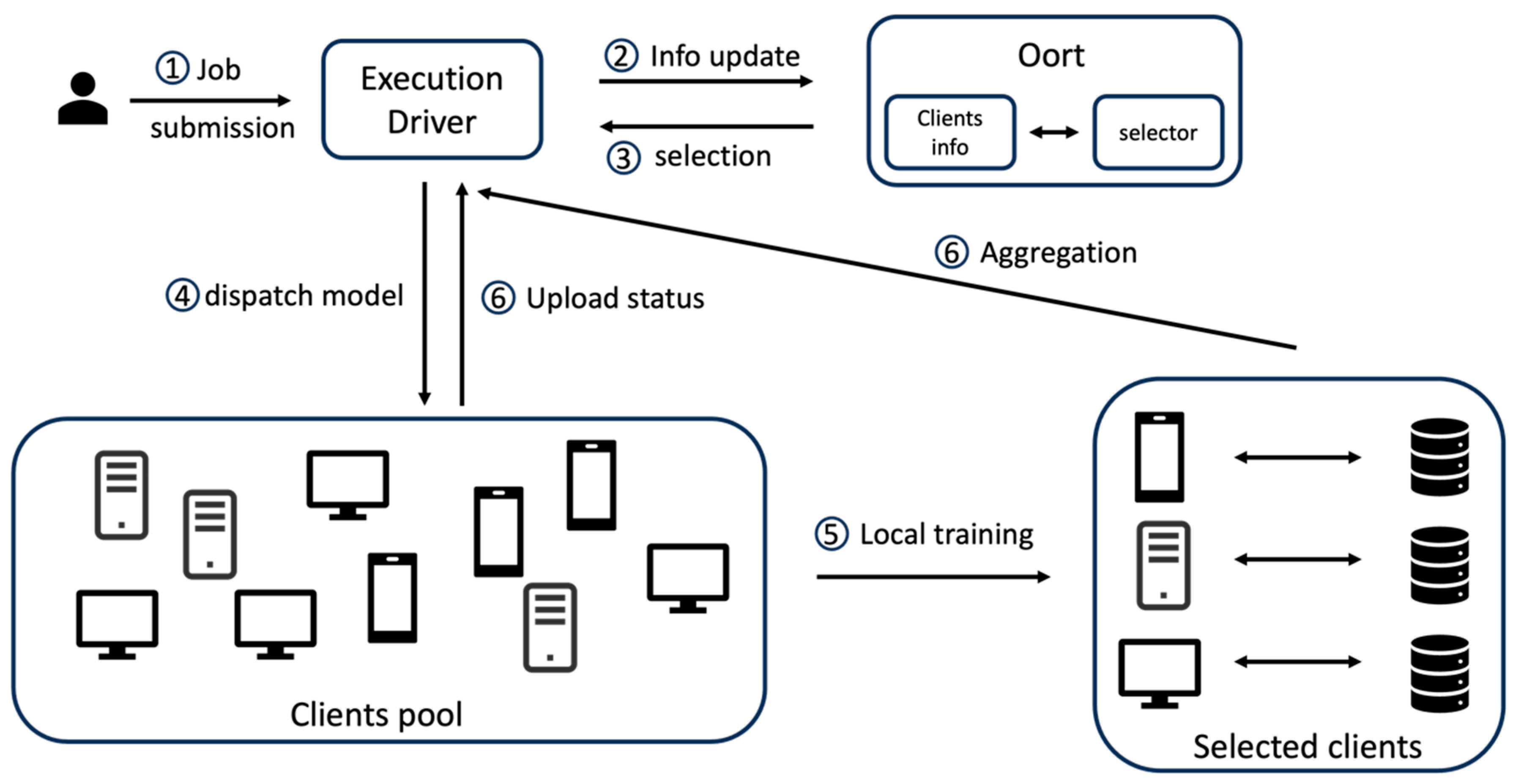
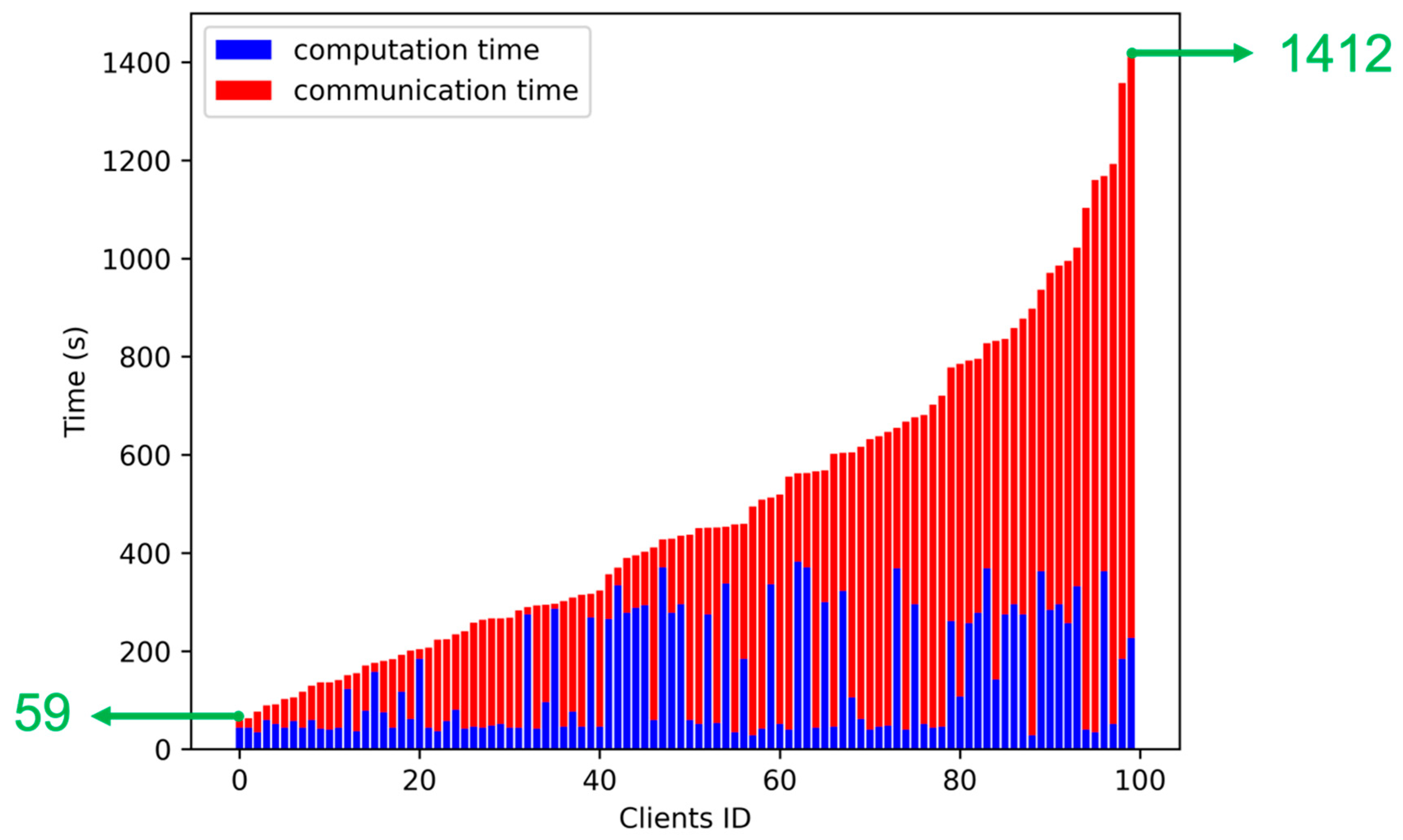
Figure 1.
The System Architecture of Oort (the indicated numbers represent the sequence order of the Oort’s execution).
Figure 1.
The System Architecture of Oort (the indicated numbers represent the sequence order of the Oort’s execution).

Figure 2.
The Overall Training Time Gap among Selected Clients by Oort (in which the experiment is conducted follows the environment settings presented in Section 5.1).
Figure 2.
The Overall Training Time Gap among Selected Clients by Oort (in which the experiment is conducted follows the environment settings presented in Section 5.1).

4. The Proposed Method
The primary objective of our proposed method is to improve communication efficiency and ensure as uniform training times as possible during the client selection process described in [18]. The Oort algorithm accounts for the heterogeneity of data and systems to identify appropriate participants. However, implementing the Oort algorithm revealed significant temporal discrepancies in training and communication. We propose integrating the Multi-branch Network into the existing Oort architecture to rectify this issue and promote enhanced communication efficiency along with uniform training times. As mentioned in Section 3, the MFedAvg method [11] does not explicitly address the impact of non-iid data, which is considered a limitation of the approach. On the other hand, combining the Oort algorithm and the multi-branch network, as proposed in this work, can effectively alleviate the impact of non-iid data suffering [11].
In the rest of this Section, we will first explain the construction of a Multi-Branch network derived from the original neural network. We will then introduce the model distributor and receiver we added to the original Oort system.
4.1. Construction of a Multi-Branch Network
Based on the findings of BranchyNet [2] and Triple wins [3], a multi-branch network can be constructed by incorporating additional branch classifiers at equidistant points within a given network, thereby facilitating model averaging. Furthermore, it has been observed that achieving satisfactory performance can be done without the addition of multiple convolutional layers to each branch. For example, we can consider the ResNet34 architecture, a classical neural network (depicted in Figure 3). Our approach incorporates several additional convolutional layers into the residual blocks at every two blocks (as illustrated in Figure 4). This modification enhances the architecture by introducing branch classifiers at equidistant points, allowing for model averaging and improved performance.
4.2. Model Distributor
Our method presents an alternative to the conventional federated learning paradigm, wherein clients are served identical models from the server. Our strategy allocates distinct model branches to various clients based on their computational capabilities and communication bandwidth. To facilitate this, we introduce a clustering algorithm that groups the clients into clusters, where denotes the number of additional branches incorporated into the model.
The initial step in the tiers clustering algorithm (Algorithm 1) involves assigning the overall training capability by considering each client’s computation capability and communication bandwidth. It is worth noting that a coefficient μ is introduced to the computation capability (Line 3), where μ represents the ratio of computation capability to communication bandwidth. This coefficient determines the relative importance of computation capability concerning communication bandwidth, with μ > 1 indicating a higher emphasis on computation capability and μ < 1 indicating a higher emphasis on communication bandwidth. When μ is equal to 1, both factors are considered equally important. Section 5 will explore the diverse outcomes achieved by employing different values of μ. Furthermore, clients are sorted (Line 5 in Algorithm 1) based on their training capability after assigning the overall training ability. They are subsequently grouped (Line 8 in Algorithm 1) into K+1 groups, arranged in ascending order according to their training times, starting from the clients with the lower training capability and progressing towards those with more substantial training capability.
With the clustering set in place, the model distributor can assign different models based on the individual training capabilities of clients. The branch models represent the initial neural network architecture's early exit points. Each signifies a specific model configuration, where corresponds to the most miniature model denoting the earliest exit of the network. Conversely, represents the complete network without any early exits.
The model distributor systematically dispatches the corresponding model to the clients within cluster to optimize the training process. This sequential assignment ensures that clients receive a model tailored to their specific training requirements, ultimately maximizing the effectiveness and efficiency of the federated learning process.
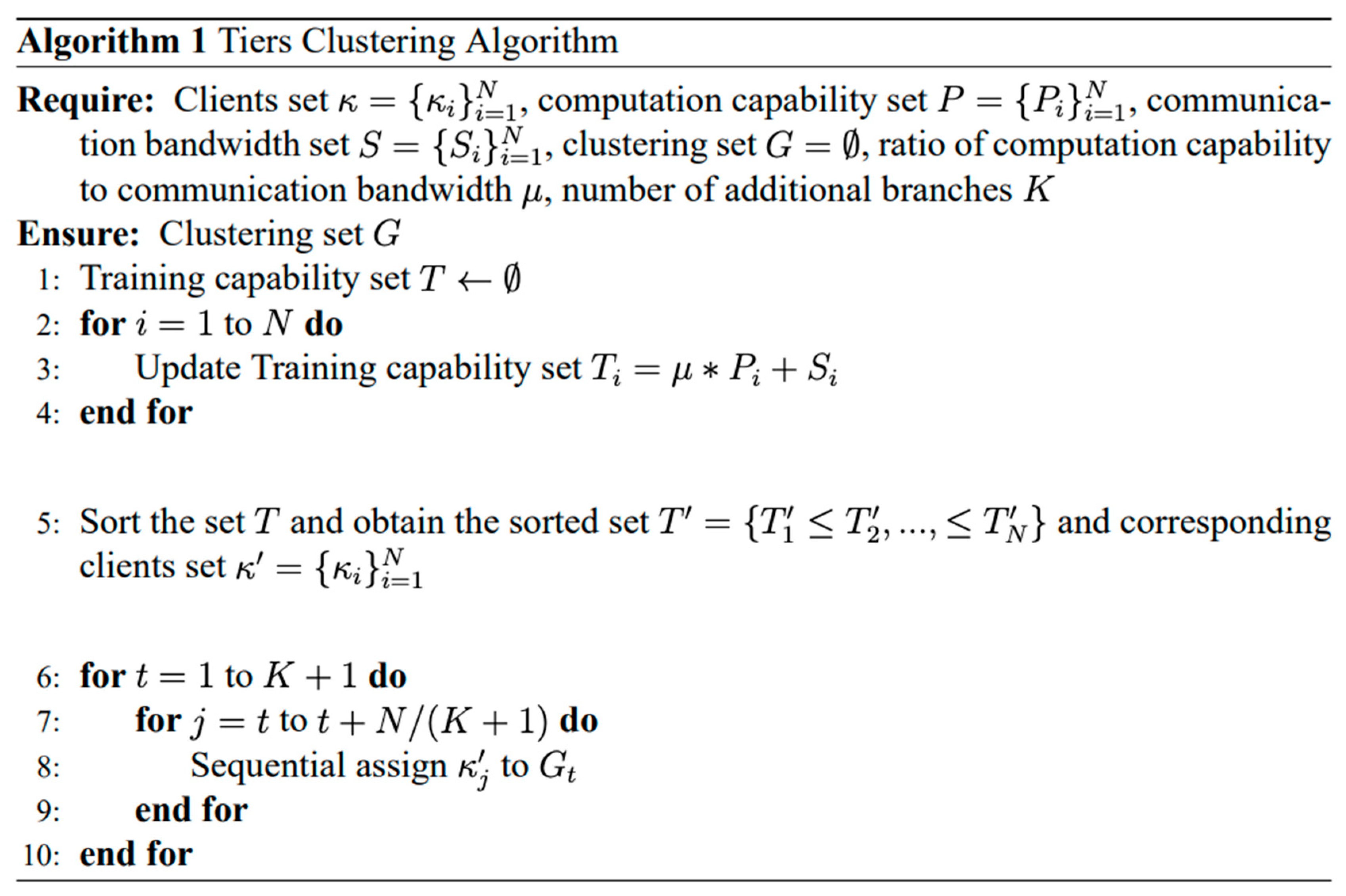
4.3. Overall System Architecture
We implemented our work using FedScale [19], an open-source evaluation platform and benchmark designed explicitly for federated learning. Figure 5 illustrates the overall system architecture of our implementation. In this architecture, the user first submits the job, which includes the hyperparameter settings (e.g., clients per round and μ), to the Parameter Aggregator (acting as the primary server) 1. Additionally, the Parameter Aggregator receives feedback from the clients regarding the previous training round, updates the global model with the clients' updates, and collects relevant information from the clients 2. Afterward, the Oort Client Selector will select a certain percentage (k%) of preferable clients based on their computing capability, communication bandwidth, and data distribution.
The remaining quota will be randomly selected from the pool of unselected clients 3. The Model Distributor receives the aforementioned information, including the updated global model, client information, and the selected clients. It utilizes the Tiers Clustering Algorithm to group the selected clients into several clusters based on their characteristics. Then, it dispatches the suitable model to each client within their respective cluster, ensuring an efficient and tailored training process 4. The clients receive the assigned models through the Model Receiver and train with their local data in Model Trainer 5. After completing the training process, the Client Collector collects the local model parameters and captures their corresponding status 6. Finally, the collected data, including the model parameters and their status, is transmitted and updated on server 7. The entire process is executed iteratively, with periodic testing every few rounds until the desired number of target rounds is reached.
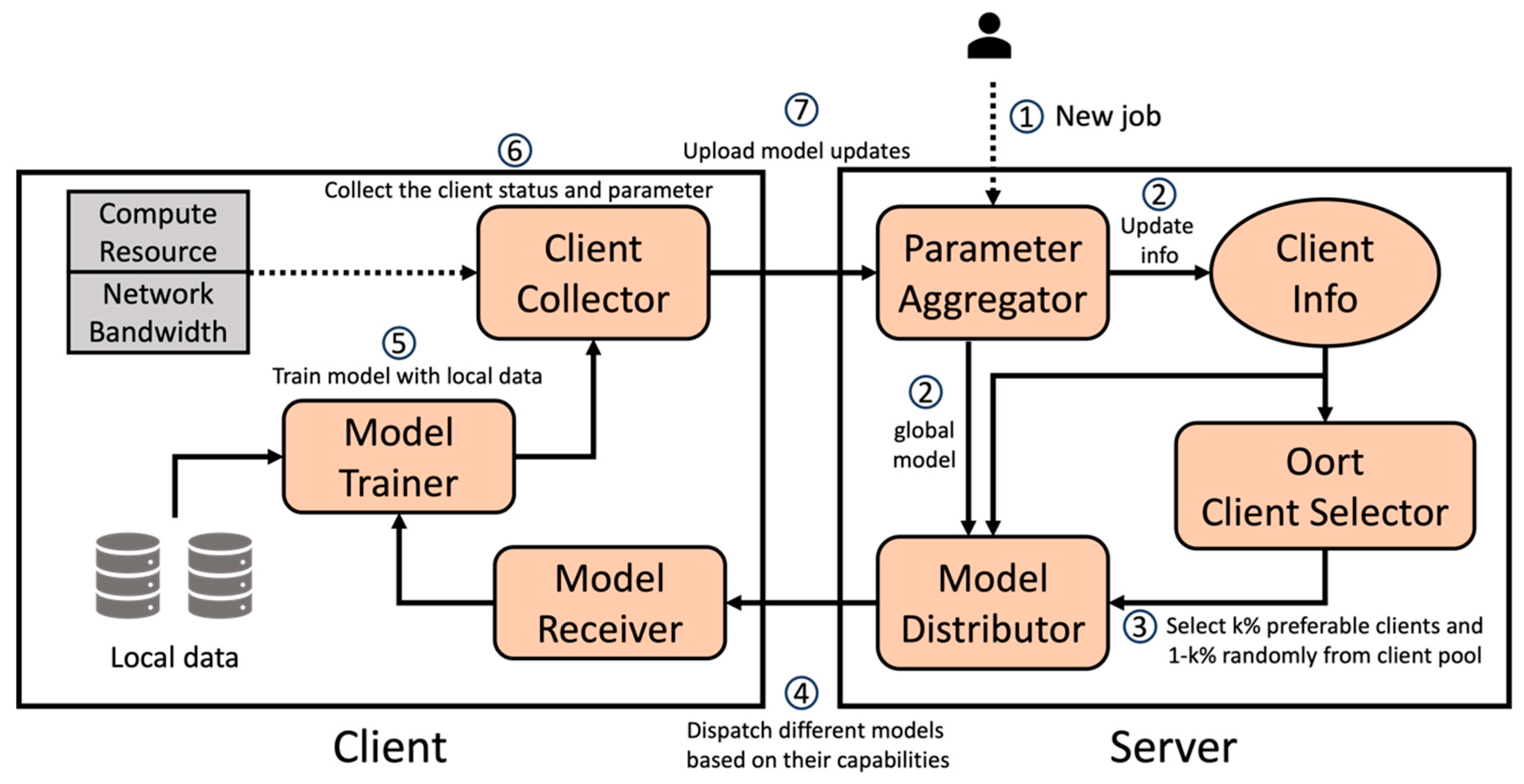
Figure 5.
The Overall System Architecture and the Functional Block Diagram of Our Proposed Framework.
Figure 5.
The Overall System Architecture and the Functional Block Diagram of Our Proposed Framework.

5. Experiments
In this Section, we perform experiments on well-known benchmark datasets, including CIFAR-10, CIFAR-100 [20], and FEMNIST [21], with the ResNet-34 model [22] and the multi-branch ResNet-34 (MB_ResNet-34). We present the experimental results in terms of two metrics: the time taken to achieve a specific accuracy (time to accuracy) and the number of rounds required to reach a certain level of accuracy (rounds to accuracy).
5.1. Experimental Setup
5.1.1. Environment Settings
Our experiments were conducted using the FedScale [19] platform, and we ensured a consistent environment setting across different dataset experiments. The client pool consisted of 2800 clients, with 100 clients selected in each round of training. We performed a total of 1000 training rounds. The datasets were divided into non-iid partitions. The computation capability of clients was predetermined prior to the training process, while the communication bandwidth of clients varied during the training process. Furthermore, the client’s online/offline status also fluctuated throughout training.
5.1.2. Model Settings
To construct the multi-branch ResNet-34 architecture, we followed the methodology described in the works of [3] and [4]. In our implementation, we incorporated additional branches into the original ResNet-34 architecture. Specifically, we added three extra branches for the first group of residual blocks. Each branch consisted of two convolutional layers followed by a fully-connected layer. These additional branches were inserted at regular intervals of every two consecutive blocks within the first group.
Similarly, we added branches combining one convolutional layer and a fully connected layer for the second group of residual blocks, following the same pattern of regular intervals. Finally, we added a single fully connected layer without any convolutional layers for the last group of residual blocks. The complete network structure, including the additional branches, is illustrated in Figure 4.
5.2. Training Details
We want to clarify that the 5.1.1 section does not explicitly mention the specific hyperparameter settings such as local training steps, batch size, and learning rate. However, it should be noted that these hyperparameters are consistent with the settings specified in the Oort [18].
We follow the training process outlined in [18] for training with the ResNet-34 model. However, there is a crucial difference in the training of the multi-branch ResNet-34 model. After selecting clients using the Oort selection algorithm, we cluster them into ten groups, corresponding to the nine additional branches and the main branch. We then assign the respective branch models to each client group for training. The detailed training process, including the Tiers Clustering Algorithm, can be found in Section 4.3.
5.3. Experimental Results
To evaluate the effectiveness of our approach, we conducted experiments on the FEMNIST and CIFAR-10 datasets using different model settings. We assessed the performance using two primary metrics: time-to-accuracy and rounds-to-accuracy. These metrics provide insights into the efficiency and effectiveness of our approach in achieving accurate results within a given time frame and number of training rounds.
5.3.1. Time-to-Accuracy Performance
Our experiments evaluated the time taken to achieve accuracy levels of 60%, 70%, and 80%. Table 3 presents the experimental results concerning the FEMNIST dataset. The first row represents the performance of the ResNet34 model without the Oort selection algorithm. It took approximately 66,761 seconds to achieve 60% accuracy and 101,072 seconds to achieve 70% accuracy. In contrast, the MB_ResNet34 model achieved the same level of accuracy in significantly less time than the original ResNet34 model.
However, it should be noted that the scenarios without the client selection algorithm faced poor overall accuracy due to the impact of non-iid data. To address this issue, we integrated the selection algorithm, as shown in the third and fourth rows of the table. It is evident that compared to the random selection method, the time to accuracy decreased, and the overall accuracy exceeded 80%.
For the CIFAR-10 dataset, as shown in Table 4, we observe similar trends to those in Table 3. This observation further supports the effectiveness of our proposed method in alleviating the negative impact of non-iid data on the MB_ResNet34 model in [11] (rows 2 and 4) and reducing the training time compared to the original ResNet34 model in [18] (rows 3 and 4).


Table 3.
Training Time versus Accuracy for Different Models on the FEMNIST Dataset (in which the symbol “” means that accuracy is not achievable due to the impact of non-iid data during the experiment).
Table 3.
Training Time versus Accuracy for Different Models on the FEMNIST Dataset (in which the symbol “” means that accuracy is not achievable due to the impact of non-iid data during the experiment).

Table 4.
Training Time versus Accuracy for Different Models on the CIFAR-10 Dataset (in which the symbol “” means that accuracy is not achievable due to the impact of non-iid data during the experiment).
Table 4.
Training Time versus Accuracy for Different Models on the CIFAR-10 Dataset (in which the symbol “” means that accuracy is not achievable due to the impact of non-iid data during the experiment).

5.3.2. Rounds-to-Accuracy Performance
Figure 6 and Figure 7 display the rounds to accuracy curves during 1000 rounds. These curves provide a more precise visualization of the overall accuracy trends. It is evident that the red line, representing the MB_ResNet34 + Oort model, achieves the highest accuracy compared to the other curves. On the other hand, the blue and orange lines, which correspond to models trained without the selection algorithm, exhibit lower accuracy levels.
5.3.3. Uniformity
We also evaluate the uniformity, as defined in Equation (1), of the original ResNet34 and MB_ResNet34 models. The physical meaning of Eq. (1) is similar to that of the variance but slightly modified to better capture the concept of uniformity.
In Equation (1), refers to the time the i-th client during the training process, and represents the minimum time spent by any client. By calculating the squared deviation of each client's time from the minimum time and then averaging them, we measure the uniformity of the training process across selected clients. Taking the result’s square root further helps provide a more interpretable value for the uniformity metric.
By utilizing the formula mentioned above, we can gain valuable insights into the consistency and uniformity of the training process for the original ResNet34 and MB_ResNet34 models, as depicted in Figure 8 and Figure 9, respectively. As a reference, we also include the variance in total training time and the uniformity of computation time and communication time. Evidently, the uniformity significantly decreases from approximately 532 to 313 when implementing the multi-branch network. This fact demonstrates the effectiveness of the multi-branch network in improving the uniformity and consistency of the training process.
5.4. Ablation Studies
5.4.1. Integration with Other Methods
In addition to conducting experiments with ResNet34 and MB_ResNet34 on CIFAR-10 and FEMNIST datasets, we also explored their performance in combination with the FedProx method [12] and FedYogi method [13]. These methods were employed to address the impact of non-iid data, reducing the time required to achieve the desired accuracy. Table 5 presents the training time-to-accuracy performance for the two models combined with different gradient policies. It is important to note that all experiments in the ablation study were performed with Oort client selection.
The results indicate that integrating MB_ResNet34 with the FedProx method yielded the best performance. However, when combined with the FedYogi method, MB_ResNet34 required more time than its standalone version. This additional time can be attributed to the computation overhead in calculating the gradient corrections. Furthermore, we extended our experiments to the CIFAR-100 dataset, and the results in Table 6 demonstrate a reduction in training time due to better uniformity among selected clients.
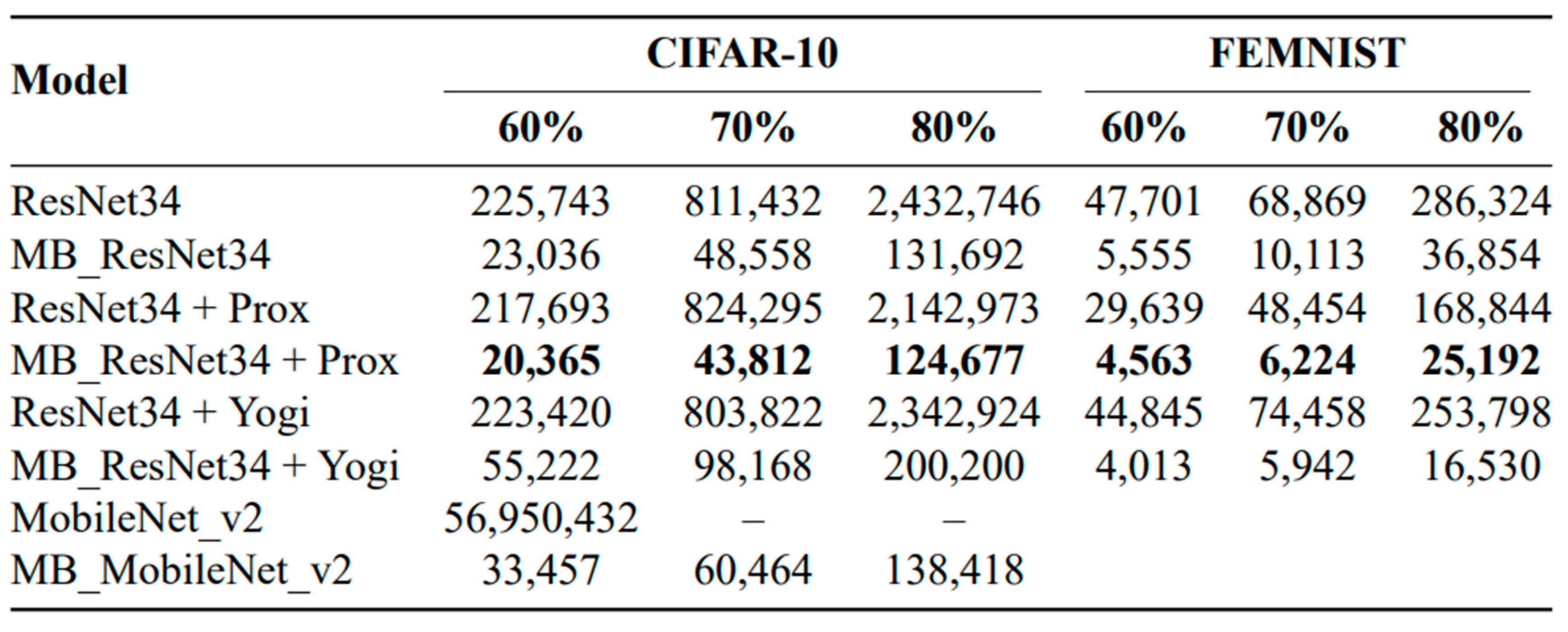
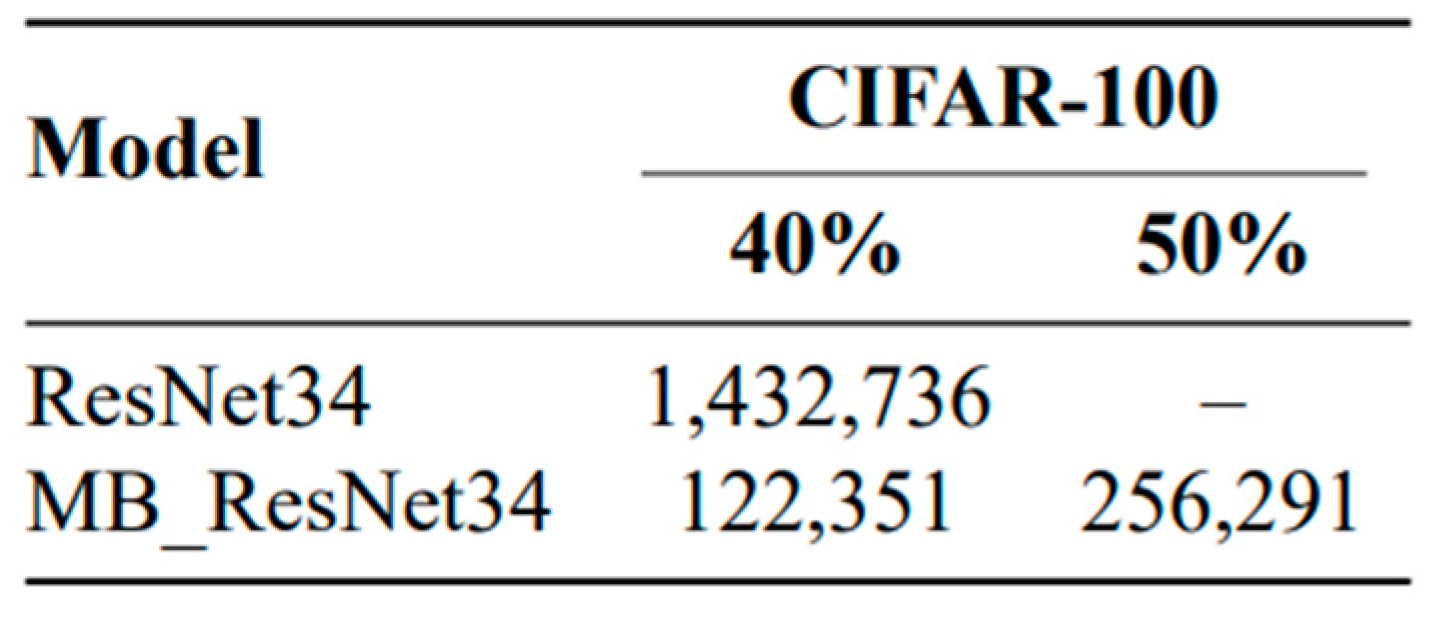
Table 5.
Training Time versus A Certain Amount of Accuracy for Different Models on CIFAR-10 and FEMNIST Datasets.
Table 5.
Training Time versus A Certain Amount of Accuracy for Different Models on CIFAR-10 and FEMNIST Datasets.

Table 6.
Training Time versus A Certain Amount of Accuracy for Different Models on CIFAR-100 Dataset.
Table 6.
Training Time versus A Certain Amount of Accuracy for Different Models on CIFAR-100 Dataset.

5.4.2. The Effects of Different Communication Bandwidth Ratios (μ)
To better understand the impact of uniformity by different μ values, we conducted experiments using extreme values in our clustering algorithm. The results are depicted in Figure 10.
By testing these extreme values, we observed that the uniformity performance improved when the computation capability and communication bandwidth were more balanced. Specifically, the extreme values represented by the bottom left and bottom right in Figure 10 demonstrated poorer uniformity performance than both on the top. The worst performance case occurred when there was an overindulgence in computation capability. In most federated learning scenarios, the straggler spent significant time in transit, transferring data rather than actively performing computations. This imbalance between computation and communication resulted in a decrease in uniformity performance.
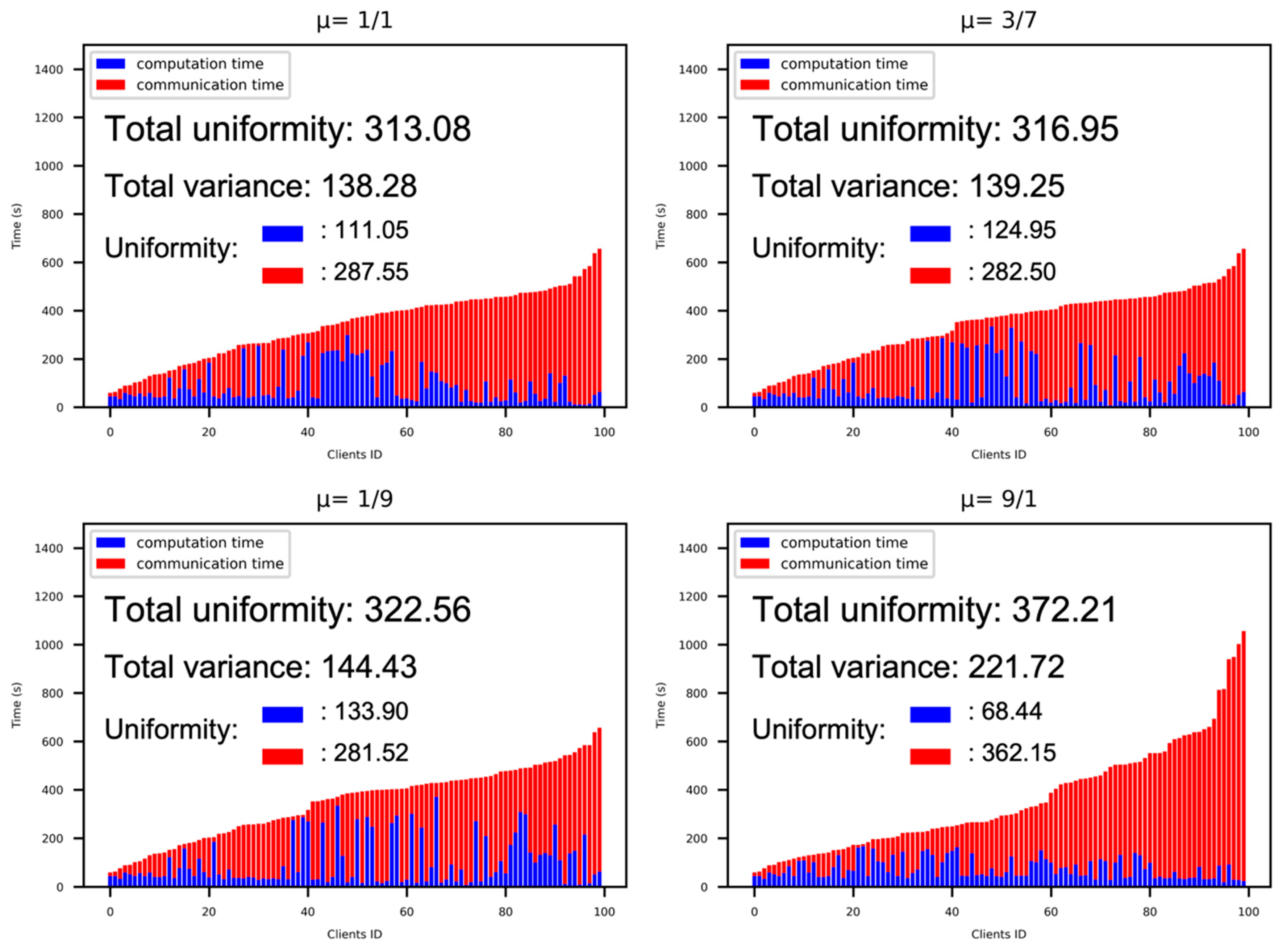
Figure 10.
The Uniformity Measures Under Different Values of μ.

6. Conclusions
This paper presents an approach integrating a multi-branch network with the Oort client selection algorithm. Our proposed method includes incorporating a Model Distributor module, which efficiently clusters clients and dispatches appropriate models to them. Through extensive experimentation, we have demonstrated the effectiveness of our approach in mitigating the impact of non-iid data, which is not considered in the MFedAvg method. Furthermore, our approach surpasses the performance of the original Oort paper.
Additionally, we have introduced the concept of uniformity, which provides a straightforward measure of the training time gap among participants and identifies the presence of stragglers. The concept of uniformity offers valuable insights into the distribution of training time and facilitates the assessment of fairness and efficiency in the federated learning process.
Our results have showcased the benefits of integrating a multi-branch network and the Oort client selection algorithm. Furthermore, we have emphasized the significance of considering uniformity in designing and evaluating federated learning frameworks.
In the future, we will conduct further investigations to enhance the overall accuracy of our approach. We plan to explore various techniques, including model architecture modifications, optimization algorithms, and the incorporation of additional data preprocessing methods. Moreover, we will conduct experiments on larger datasets to gain insights into the scalability and generalizability of our approach. We aim to refine and optimize our approach by undertaking these efforts, ultimately achieving higher accuracy and better performance in federated learning.
Acknowledgments
This research is partially supported by the Minister of Science and Technology, Taiwan: MOST 111-2221-E-002-134-MY3, National Taiwan University: NTU-112L900902, and Taiwan Semiconductor Manufacturing: TSMC 112H1002-D.
References
- Brendan McMahan, Eider Moore, Daniel Ramage, Seth Hampson, and Blaise Agueray Arcas. Communication-efficient Learning of Deep Networks from Decentralized Data. In Artificial Intelligence and Statistics, pp. 1273–1282. PMLR, 2017.
- Teerapittayanon, S.; McDanel, B.; Kung, H.-T. BranchyNet: Fast inference via early exiting from deep neural networks. In Proceedings od the 23rd IEEE International Conference on Pattern Recognition (ICPR), Cancun, Mexico, 4–8 December 2016; pp. 2464–2469.
- Hu, T.-K.; Chen, T.; Wang, H.; Wang, Z. Triple Wins: Boosting Accuracy, Robustness and Efficiency Together by Enabling Input-Adaptive Inference. arXiv 2020, arXiv:2002.10025. [Google Scholar] [CrossRef]
- Lim, W.Y.B.; Luong, N.C.; Hoang, D.T.; Jiao, Y.; Liang, Y.-C.; Yang, Q.; Niyato, D.; Miao, C. Federated Learning in Mobile Edge Networks: A Comprehensive Survey. IEEE Commun. Surv. Tutorials 2020, 22, 2031–2063. [Google Scholar] [CrossRef]
- Banabilah, S.; Aloqaily, M.; Alsayed, E.; Malik, N.; Jararweh, Y. Federated learning review: Fundamentals, enabling technologies, and future applications. Inf. Process. Manag. 2022, 59, 103061. [Google Scholar] [CrossRef]
- Zhang, T.; Gao, L.; He, C.; Zhang, M.; Krishnamachari, B.; Avestimehr, A.S. Federated Learning for the Internet of Things: Applications, Challenges, and Opportunities. IEEE Internet Things Mag. 2022, 5, 24–29. [Google Scholar] [CrossRef]
- Antunes, R.S.; da Costa, C.A.; Küderle, A.; Yari, I.A.; Eskofier, B. Federated Learning for Healthcare: Systematic Review and Architecture Proposal. ACM Trans. Intell. Syst. Technol. 2022, 13, 1–23. [Google Scholar] [CrossRef]
- Linlin Tu, Xiaomin Ouyang, Jiayu Zhou, Yuze He, and Guoliang Xing. Feddl: Federated Learning via Dynamic Layer Sharing for Human Activity Recognition. In Proceedings of the 19th ACM Conference on Embedded Networked Sensor Systems, pp. 15–28, 2021.
- Wu, Q.; He, K.; Chen, X. Personalized Federated Learning for Intelligent IoT Applications: A Cloud-Edge Based Framework. IEEE Open J. Comput. Soc. 2020, 1, 35–44. [Google Scholar] [CrossRef]
- Kairouz, P.; McMahan, H.B.; Avent, B.; Bellet, A.; Bennis, M.; Bhagoji, A.N.; Bonawitz, K.; Charles, Z.; Cormode, G.; Cummings, R.; et al. Advances and Open Problems in Federated Learning. Found. Trends Mach. Learn. 2021, 14, 1–210. [Google Scholar] [CrossRef]
- Ching-Hao Wang, Kang-Yang Huang, Jun-Cheng Chen, Hong-Han Shuai, and Wen-Huang Cheng. Heterogeneous Federated Learning through Multi-Branch Network. In 2021 IEEE International Conference on Multimedia and Expo (ICME), pp. 1–6. IEEE, 2021.
- Li, T.; Sahu, A.K.; Zaheer, M.; Sanjabi, M.; Talwalkar, A.; Smith, V. Federated Optimization in Heterogeneous Networks. Proceedings of 3rd Machine Learning and Systems, Austin, TX, USA, 2–4 March 2020; Volume 2, pp. 429–450. Available online: https://arxiv.org/pdf/1812.06127.
- Ashank Reddi, Zachary Charles, Manzil Zaheer, Zachary Garrett, Keith Rush, Jakub Konečnỳ, Sanjiv Kumar, and H Brendan McMahan. Adaptive Federated Optimization. arXiv:2003.00295, 2020.
- Li, K.; Wang, H.; Zhang, Q. FedTCR: communication-efficient federated learning via taming computing resources. Complex Intell. Syst. 2023, 9, 5199–5219. [Google Scholar] [CrossRef]
- Huang, H.; Zhang, L.; Sun, C.; Fang, R.; Yuan, X.; Wu, D. FEDTiny: Pruned Federated Learning towards Specialized Tiny Models. arXiv 2022, arXiv:2212.01977. [Google Scholar] [CrossRef]
- Tao Lin, Lingjing Kong, Sebastian U Stich, and Martin Jaggi. Ensemble Distillation for Robust Model Fusion in Federated Learning. 34th Conference on Neural Information Processing Systems (NeurIPS), Vancouver, Canada, 33:2351–2363, 2020.
- Daliang Li and Junpu Wang. FEDMD: Heterogenous Federated Learning via Model Distillation. arXiv preprint. arXiv:1910.03581, 2019.
- Fan Lai, Xiangfeng Zhu, Harsha V Madhyastha, and Mosharaf Chowdhury. Oort: Efficient Federated Learning via Guided Participant Selection. In the Proceedings of the 15th USENIX Symposium on Operating Systems Design and Implementation (OSDI), pp. 19–35, 2021.
- Lai, F.; Dai, Y.; Singapuram, S.; Liu, J.; Zhu, X.; Madhyastha, H.; Chowdhury, M. FedScale: Benchmarking Model and System Performance of Federated Learning at Scale. In Proceedings of the 39th International Conference on Machine Learning, Baltimore, Maryland, USA, 17–23 July 2022; pp. 11814–11827. [Google Scholar]
- Krizhevsky, A.; Hinton, G. Learning multiple layers of features from tiny images. Ph.D. Thesis, University of Toronto, Toronto, ON, Canada, 2009. [Google Scholar]
- Cohen, G.; Afshar, S.; Tapson, J.; van Schaik, A. EMNIST: An Extension of MNIST to Handwritten Letters. arXiv 2017, arXiv:1702.05373v2. Available online: https://arxiv.org/pdf/1702.05373.pdf.
- Kaiming He, Xiangyu Zhang, Shaoqing Ren, and Jian Sun. Deep Residual Learning for Image Recognition. In Proceedings of the IEEE Conference on Computer Vision and Pattern Recognition (CVPR), pp. 770–778, 2016.
Figure 3.
The Architecture of the Original ResNet34 Network.

Figure 4.
The Architecture of the Proposed Nine-Branch ResNet34 Network.
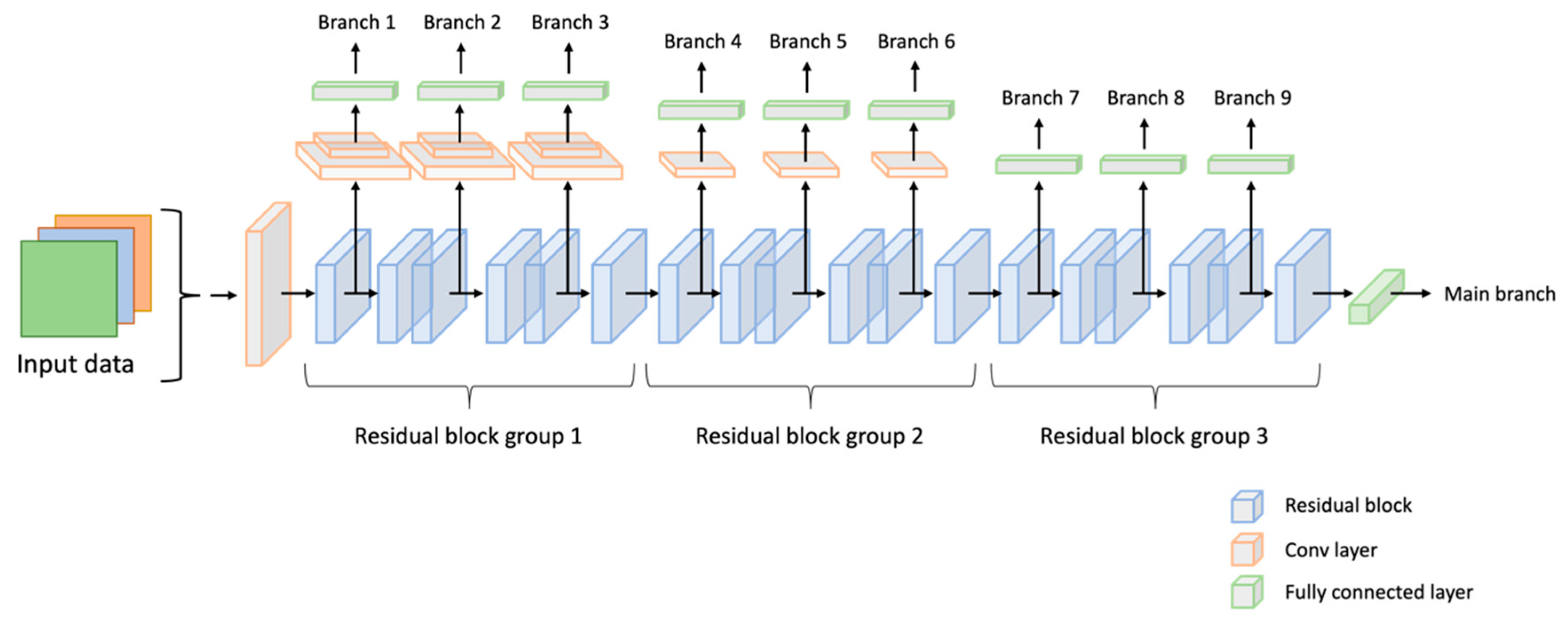
Figure 6.
Rounds versus Accuracy for Different Models on the FEMNIST Dataset.
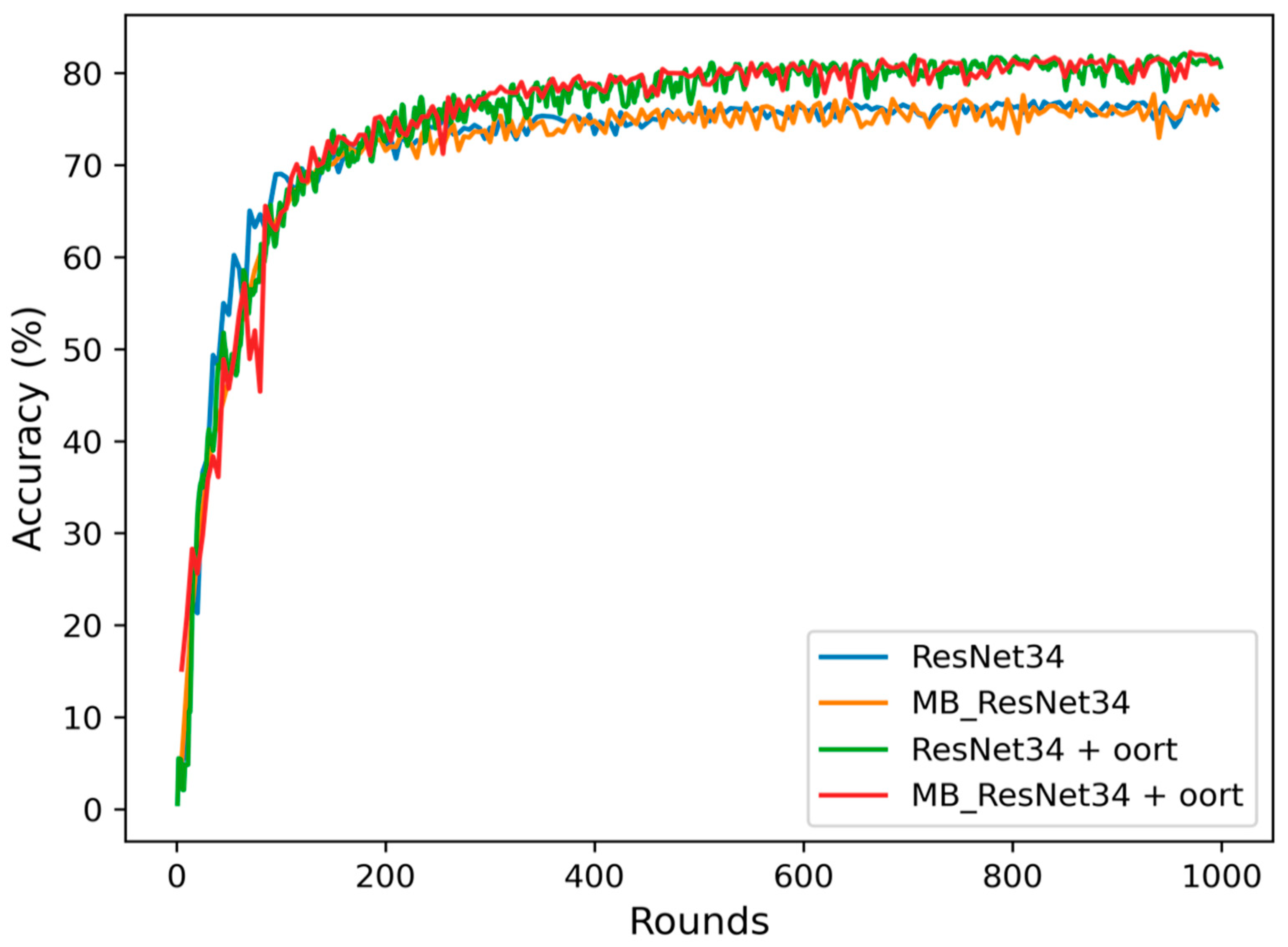
Figure 7.
Rounds versus Accuracy for Different Models on the CIFAR-10 Dataset.
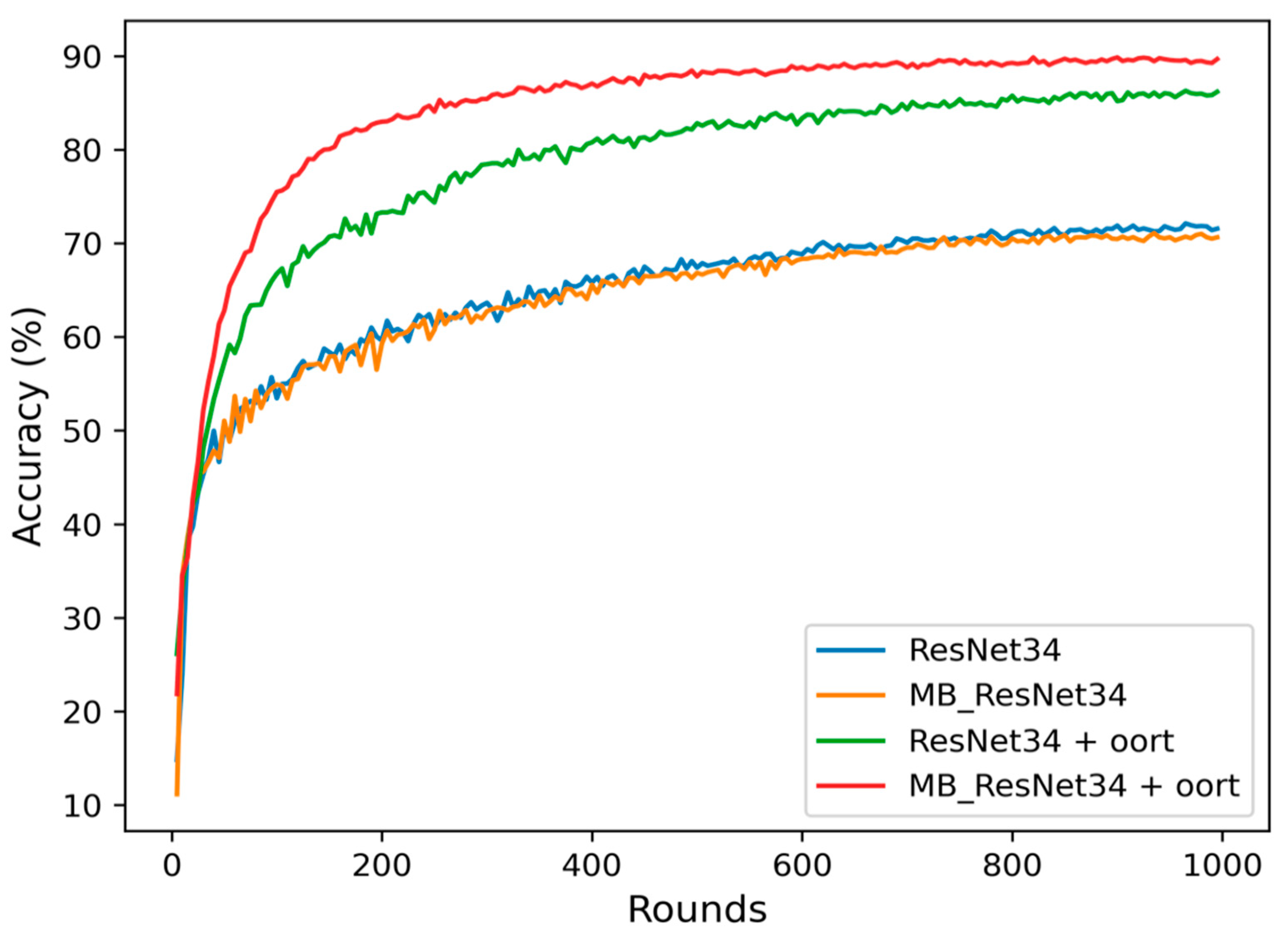
Figure 8.
The Uniformity of the Original ResNet34.
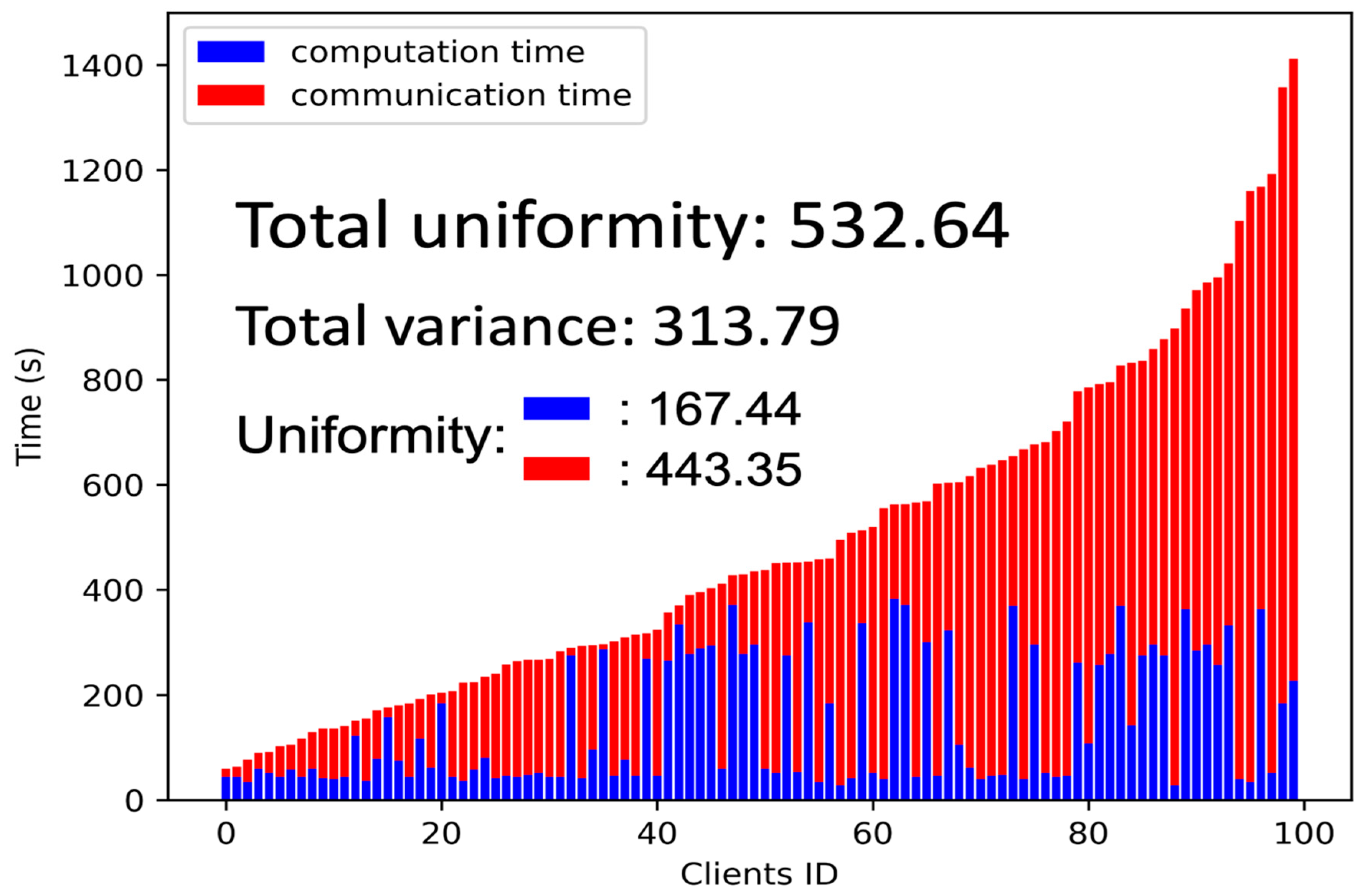
Figure 9.
The Uniformity of the MB_ResNet34.
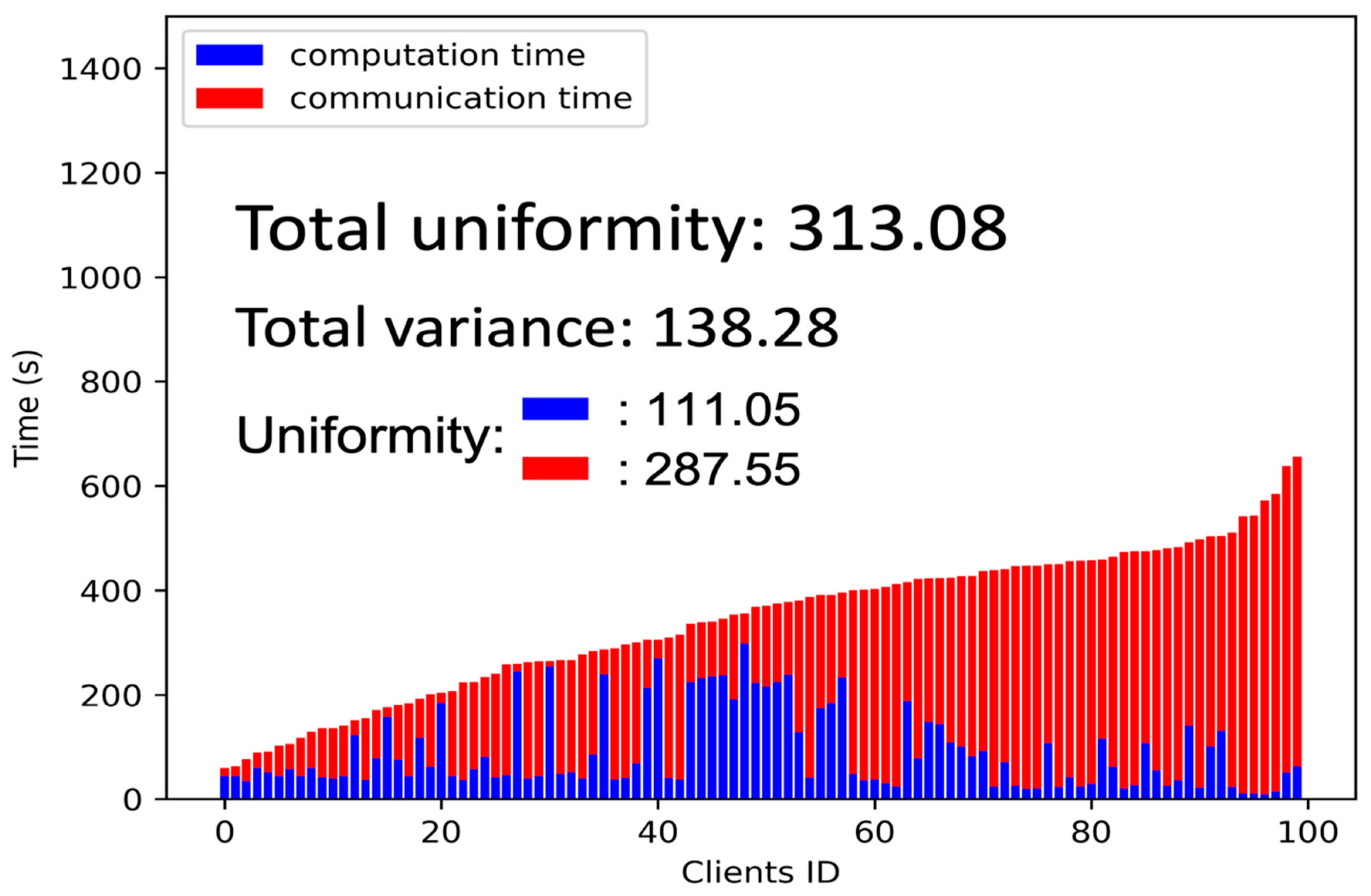
Table 1.
Summarizations of the characteristics and Limitations of the Benchmarked Federated Learning Techniques.
Table 1.
Summarizations of the characteristics and Limitations of the Benchmarked Federated Learning Techniques.
| Name of the Method |
Characteristics | Limitations |
|---|---|---|
| FedProx [12] | Add a proximal term to ensure that the local models of participants stay close to the global model. | It is challenging to select an appropriate center point for the proximal term. |
| FedYogi [13] | A gradient correction is added to further suppress the data heterogeneity and performance variations among participants | The computation cost increases with the calculation of gradient corrections, . |
| FedTCR [14] |
|
|
| FedTiny [15] | Select pruned models by evaluating client datasets and further sparsify the update parameters | The pruning procedure incurs additional computation and transmission costs |
| FedDF [16] | Utilize knowledge distillation to share information across different types of models | Need a public dataset that is unrealistic for real-world scenarios |
| MFedAvg [11] | Distribute models of different sizes to clients, allowing each client to receive and accommodate a suitable model | Doesn’t consider the scenario of non-iid data |
Table 2.
Comparisons of Benchmarked Federated Learning Techniques (in which the symbol “O” denotes the issue that has been addressed in the method).
Table 2.
Comparisons of Benchmarked Federated Learning Techniques (in which the symbol “O” denotes the issue that has been addressed in the method).
| Method//Issues | Reduce Non-iid Impact |
Alleviate Communication Bandwidth |
Alleviate Computational Capability |
Improve Transferring Speed |
|---|---|---|---|---|
| FedProx [12] | O | |||
| FedYogi [13] | O | O | ||
| FedTCR [14] | O | O | ||
| FedTiny [15] | O | O | ||
| FedDF [16] | O | O | O | |
| MFedAvg [11] | O | O | O | |
| Oort [18] | O | O | O |
Disclaimer/Publisher’s Note: The statements, opinions and data contained in all publications are solely those of the individual author(s) and contributor(s) and not of MDPI and/or the editor(s). MDPI and/or the editor(s) disclaim responsibility for any injury to people or property resulting from any ideas, methods, instructions or products referred to in the content. |
© 2023 by the authors. Licensee MDPI, Basel, Switzerland. This article is an open access article distributed under the terms and conditions of the Creative Commons Attribution (CC BY) license (http://creativecommons.org/licenses/by/4.0/).
Copyright: This open access article is published under a Creative Commons CC BY 4.0 license, which permit the free download, distribution, and reuse, provided that the author and preprint are cited in any reuse.
Submitted:
20 December 2023
Posted:
20 December 2023
You are already at the latest version
Alerts
A peer-reviewed article of this preprint also exists.
This version is not peer-reviewed
Submitted:
20 December 2023
Posted:
20 December 2023
You are already at the latest version
Alerts
Abstract
In this study, we present a federated learning approach that combines a multi-branch network and the Oort client selection algorithm to improve the performance of federated learning systems. This method successfully addresses the significant issue of non-iid data, a challenge not adequately tackled by the commonly used MFedAvg method. Additionally, one of the key innovations of this research is the introduction of uniformity, a metric that quantifies the disparity in training time amongst participants in a federated learning setup. This novel concept not only aids in identifying stragglers but also provides valuable insights into assessing the fairness and efficiency of the system. Experimental results underscore the merits of the integrated multi-branch network with the Oort client selection algorithm and highlight the crucial role of uniformity in designing and evaluating federated learning systems.
Keywords:
Subject: Computer Science and Mathematics - Artificial Intelligence and Machine Learning
1. Introduction
Federated learning (FL) [1] has emerged as a powerful approach for training machine learning models on decentralized data without compromising data privacy. It allows multiple clients to collaboratively train a shared global model while keeping their data locally. This distributed learning paradigm has gained significant attention and has been applied to various domains, including healthcare, finance, and the Internet of Things (IoT).
The primary objective of federated learning is to improve communication efficiency and ensure uniform training times among clients; however, the heterogeneity of data and systems in federated learning challenges client selection and training processes. Selecting appropriate clients to participate in training becomes crucial to achieving accurate and efficient model updates.
In this context, the Oort algorithm has been proposed as a client selection method that considers the heterogeneity of data and systems. However, implementing the Oort algorithm (detailed in Section 3.3) has revealed temporal discrepancies in training and communication, leading to inefficient federated learning.
We propose integrating the Multi-Branch Network (MBN) into the existing Oort architecture to address this issue and enhance communication efficiency and training uniformity. The MBN construction is inspired by BranchyNet [2] and Triplewins [3], where additional branch classifiers are incorporated at equidistant points within a given neural network. This modification allows for model averaging and improved performance without needing multiple convolutional layers in each branch.
Furthermore, we introduce a Model Distributor component to allocate different model branches to clients based on their computational capabilities and communication bandwidth. This clustering-based approach ensures that clients receive models tailored to their specific training requirements, optimizing the effectiveness and efficiency of the federated learning process.
This work presents the construction of the MBN and the Model Distributor in detail. We evaluate the performance of our proposed method on benchmark datasets, including CIFAR-10 and FEMNIST, using the ResNet34 model and the MBN. We measure the training time to achieve specific accuracy levels and the number of rounds required to reach the desired performance. Additionally, we analyze the uniformity of the training process and investigate the impact of different hyperparameters.
The rest of this paper is organized as follows: Section 2 provides background information on federated learning and MBN. Section 3 explores the related work in federated learning. Section 4 describes the construction of the MBN and the Model Distributor. Section 5 presents the experimental results and discusses the findings. Finally, Section 6 concludes the thesis and outlines potential directions for future research.
2. Preliminary
2.1. Federated Learning
Federated Learning has emerged as a promising approach in machine learning, enabling decentralized training while addressing privacy and data ownership concerns. The Federated Averaging (FedAvg) algorithm proposed by McMahan et al. [1] is widely used for global aggregation in FL.
FL leverages the power of local devices such as smartphones and tablets to perform model training while a central server aggregates the locally computed updates [4]. This distribution of the learning process brings several advantages [5,6]. Firstly, it mitigates privacy risks by avoiding transferring sensitive data to a central location. Secondly, FL allows the utilization of device-specific data that would otherwise be challenging to access due to privacy or logistical constraints [7,8,9].
However, FL also presents its inherent challenges [6,10]. One such challenge is data heterogeneity, where the data distribution across different devices may vary significantly. This heterogeneity can affect the convergence and performance of FL models.
Another challenge is the heterogeneity of computing resources among client devices. Some clients may have limited computational capabilities or unreliable network connections, which can lead to stragglers, slowing down the overall FL process.
Moreover, Communication efficiency is another crucial factor in FL. Since clients must frequently communicate with the central server to obtain the latest model updates, efficient communication protocols and strategies are necessary to reduce communication overhead.
In the upcoming Section, we will delve into various research works that aim to tackle these challenges, including data and computing resource heterogeneity and communication efficiency.
2.2. Multi-Branch Networks
The concept of multi-branch networks was first introduced in [2] and further developed in [3]. In contrast to traditional neural networks, which only have a single exit point, multi-branch networks are designed to incorporate multiple exit points. This architecture features numerous early-branch output layers and the standard final output layer, enhancing the network's capability to capture and leverage diverse intermediate representations from various branches. As a result, it enhances performance and versatility in handling intricate tasks.
The early-branch output layers within a multi-branch network facilitate extracting specific features or representations at intermediary stages of network processing. By offering auxiliary outputs or intermediate predictions, these layers contribute significantly to guiding the network's learning process and provide additional regularization to fortify the network's stability and generalization.
Considering the benefits of multi-branch networks, it is advantageous to employ them as the training model in Federated Learning environments [11]. Their architectural features lend to enhanced learning and adaptability, making them a suitable choice for the diverse and distributed nature of FL systems.
3. Related Work
Several academic papers have put forth various methodologies to address the challenges mentioned in the preliminary section regarding Federated Learning. These approaches can be broadly categorized into homogeneous model FL and heterogeneous model FL. Table 1 summarizes the characteristics and limitations of each considered related work. Moreover, a comparison of the reduction in Non-iid Impacts, Alleviation in Communication Bandwidth, Alleviation in Computational Capability, and Improvement in Transferring Speed among the benchmarking works is presented in Table 2.
3.1. Homogeneous Model FL
To address the challenge of non-iid (non-independent and identically distributed) data in FL, Li et al. propose FedProx [12]. It introduces a proximal term to the FedAvg algorithm, a commonly used algorithm in FL for aggregating local model updates from participant devices. The proximal term in FedProx aims to keep the local models of participants close to the global model by imposing a penalty if the local data are biased. This penalty encourages participants to contribute updates that align with the global model. Building upon FedProx, Reddi et al. proposed FedYogi [13]. FedYogi enhances FedProx by introducing gradient corrections. These corrections consider the performance variations among participants and adaptively adjust the importance of each participant's parameter updates to the server. By considering the individual participants' performance, FedYogi aims to better use the updates from participants with higher reliability or accurate data while reducing the impact of updates from participants with less reliable data. However, calculating the gradient corrections in FedYogi can introduce additional computation overhead, potentially procrastinating the training time.
By minimizing the variability in total computing resources within each group, Fed-TCR [14] aims to tackle the challenge of resource heterogeneity among participants in federated learning. This approach helps ensure that every group can collectively contribute to the training process without significant discrepancies in computing capabilities. Only the client with the most substantial computing resources in each group can directly communicate with the server. At the same time, the remaining participants exchange the model update with the cluster head to alleviate the communication overhead on the server. While this architecture can reduce communication costs and address the heterogeneity of computing resources, it may introduce privacy concerns as the trustworthiness of the cluster head is not guaranteed.
As an intuitive approach to reducing communication costs, FedTiny [15] introduces a unique method to address the challenge of non-iid data. It achieves this by employing model pruning techniques. FedTiny creates multiple pruned models and allows participants to update the batch normalization layer to analyze their data distribution indirectly. The server can select a model with a minimum bias for each participant from the candidate model pool. However, this approach still suffers from a decrease in overall accuracy due to discarding specific parameters during the pruning process.
3.2. Heterogeneous Model FL
In contrast to federated learning with homogeneous models, FedDF [16] employs knowledge distillation to extract logits from participants [17]. By obtaining the logits, the server can update prototype models on the server side, eliminating the need for participants to update the parameters of their local models. This approach allows FedDF to accommodate the heterogeneity of model settings, enabling variations in model architectures among participants. However, it should be noted that FedDF requires a proxy dataset to perform the distillation process, which may be unrealistic in real-world scenarios.
On the other hand, MFedAvg [11] utilizes a multi-branch network to leverage federated learning with heterogeneous models. By assigning the early exit branch to weak clients and the whole model to substantial clients, MFedAvg effectively mitigates the discrepancy in computation capability and communication bandwidth among clients. Unfortunately, MFedAvg does not address the impact of non-iid data, which is a limitation.
3.3. Oort—Clients Selection for FL
Unlike previous works that address specific challenges, Oort [18] proposes a client selection framework to select high-quality clients for effective participation in the training job. It utilizes a utility function to measure clients' priority based on three dimensions: data distribution, computing resources, and communication bandwidth. The system architecture of Oort is depicted in Figure 1.
However, even if the Oort framework selects preferable clients, there may still be a significant training time gap among the selected clients. According to our experimental results, as the green numbers in Figure 2 show, the fastest client needs to wait for the slowest client for nearly 1400 seconds to complete the whole training, which significantly burdens the overall training performance. This surprising observation inspires us to investigate ways to enhance the overall efficacy of FML.


Figure 1.
The System Architecture of Oort (the indicated numbers represent the sequence order of the Oort’s execution).
Figure 1.
The System Architecture of Oort (the indicated numbers represent the sequence order of the Oort’s execution).

Figure 2.
The Overall Training Time Gap among Selected Clients by Oort (in which the experiment is conducted follows the environment settings presented in Section 5.1).
Figure 2.
The Overall Training Time Gap among Selected Clients by Oort (in which the experiment is conducted follows the environment settings presented in Section 5.1).

4. The Proposed Method
The primary objective of our proposed method is to improve communication efficiency and ensure as uniform training times as possible during the client selection process described in [18]. The Oort algorithm accounts for the heterogeneity of data and systems to identify appropriate participants. However, implementing the Oort algorithm revealed significant temporal discrepancies in training and communication. We propose integrating the Multi-branch Network into the existing Oort architecture to rectify this issue and promote enhanced communication efficiency along with uniform training times. As mentioned in Section 3, the MFedAvg method [11] does not explicitly address the impact of non-iid data, which is considered a limitation of the approach. On the other hand, combining the Oort algorithm and the multi-branch network, as proposed in this work, can effectively alleviate the impact of non-iid data suffering [11].
In the rest of this Section, we will first explain the construction of a Multi-Branch network derived from the original neural network. We will then introduce the model distributor and receiver we added to the original Oort system.
4.1. Construction of a Multi-Branch Network
Based on the findings of BranchyNet [2] and Triple wins [3], a multi-branch network can be constructed by incorporating additional branch classifiers at equidistant points within a given network, thereby facilitating model averaging. Furthermore, it has been observed that achieving satisfactory performance can be done without the addition of multiple convolutional layers to each branch. For example, we can consider the ResNet34 architecture, a classical neural network (depicted in Figure 3). Our approach incorporates several additional convolutional layers into the residual blocks at every two blocks (as illustrated in Figure 4). This modification enhances the architecture by introducing branch classifiers at equidistant points, allowing for model averaging and improved performance.
4.2. Model Distributor
Our method presents an alternative to the conventional federated learning paradigm, wherein clients are served identical models from the server. Our strategy allocates distinct model branches to various clients based on their computational capabilities and communication bandwidth. To facilitate this, we introduce a clustering algorithm that groups the clients into clusters, where denotes the number of additional branches incorporated into the model.
The initial step in the tiers clustering algorithm (Algorithm 1) involves assigning the overall training capability by considering each client’s computation capability and communication bandwidth. It is worth noting that a coefficient μ is introduced to the computation capability (Line 3), where μ represents the ratio of computation capability to communication bandwidth. This coefficient determines the relative importance of computation capability concerning communication bandwidth, with μ > 1 indicating a higher emphasis on computation capability and μ < 1 indicating a higher emphasis on communication bandwidth. When μ is equal to 1, both factors are considered equally important. Section 5 will explore the diverse outcomes achieved by employing different values of μ. Furthermore, clients are sorted (Line 5 in Algorithm 1) based on their training capability after assigning the overall training ability. They are subsequently grouped (Line 8 in Algorithm 1) into K+1 groups, arranged in ascending order according to their training times, starting from the clients with the lower training capability and progressing towards those with more substantial training capability.
With the clustering set in place, the model distributor can assign different models based on the individual training capabilities of clients. The branch models represent the initial neural network architecture's early exit points. Each signifies a specific model configuration, where corresponds to the most miniature model denoting the earliest exit of the network. Conversely, represents the complete network without any early exits.
The model distributor systematically dispatches the corresponding model to the clients within cluster to optimize the training process. This sequential assignment ensures that clients receive a model tailored to their specific training requirements, ultimately maximizing the effectiveness and efficiency of the federated learning process.

4.3. Overall System Architecture
We implemented our work using FedScale [19], an open-source evaluation platform and benchmark designed explicitly for federated learning. Figure 5 illustrates the overall system architecture of our implementation. In this architecture, the user first submits the job, which includes the hyperparameter settings (e.g., clients per round and μ), to the Parameter Aggregator (acting as the primary server) 1. Additionally, the Parameter Aggregator receives feedback from the clients regarding the previous training round, updates the global model with the clients' updates, and collects relevant information from the clients 2. Afterward, the Oort Client Selector will select a certain percentage (k%) of preferable clients based on their computing capability, communication bandwidth, and data distribution.
The remaining quota will be randomly selected from the pool of unselected clients 3. The Model Distributor receives the aforementioned information, including the updated global model, client information, and the selected clients. It utilizes the Tiers Clustering Algorithm to group the selected clients into several clusters based on their characteristics. Then, it dispatches the suitable model to each client within their respective cluster, ensuring an efficient and tailored training process 4. The clients receive the assigned models through the Model Receiver and train with their local data in Model Trainer 5. After completing the training process, the Client Collector collects the local model parameters and captures their corresponding status 6. Finally, the collected data, including the model parameters and their status, is transmitted and updated on server 7. The entire process is executed iteratively, with periodic testing every few rounds until the desired number of target rounds is reached.

Figure 5.
The Overall System Architecture and the Functional Block Diagram of Our Proposed Framework.
Figure 5.
The Overall System Architecture and the Functional Block Diagram of Our Proposed Framework.

5. Experiments
In this Section, we perform experiments on well-known benchmark datasets, including CIFAR-10, CIFAR-100 [20], and FEMNIST [21], with the ResNet-34 model [22] and the multi-branch ResNet-34 (MB_ResNet-34). We present the experimental results in terms of two metrics: the time taken to achieve a specific accuracy (time to accuracy) and the number of rounds required to reach a certain level of accuracy (rounds to accuracy).
5.1. Experimental Setup
5.1.1. Environment Settings
Our experiments were conducted using the FedScale [19] platform, and we ensured a consistent environment setting across different dataset experiments. The client pool consisted of 2800 clients, with 100 clients selected in each round of training. We performed a total of 1000 training rounds. The datasets were divided into non-iid partitions. The computation capability of clients was predetermined prior to the training process, while the communication bandwidth of clients varied during the training process. Furthermore, the client’s online/offline status also fluctuated throughout training.
5.1.2. Model Settings
To construct the multi-branch ResNet-34 architecture, we followed the methodology described in the works of [3] and [4]. In our implementation, we incorporated additional branches into the original ResNet-34 architecture. Specifically, we added three extra branches for the first group of residual blocks. Each branch consisted of two convolutional layers followed by a fully-connected layer. These additional branches were inserted at regular intervals of every two consecutive blocks within the first group.
Similarly, we added branches combining one convolutional layer and a fully connected layer for the second group of residual blocks, following the same pattern of regular intervals. Finally, we added a single fully connected layer without any convolutional layers for the last group of residual blocks. The complete network structure, including the additional branches, is illustrated in Figure 4.
5.2. Training Details
We want to clarify that the 5.1.1 section does not explicitly mention the specific hyperparameter settings such as local training steps, batch size, and learning rate. However, it should be noted that these hyperparameters are consistent with the settings specified in the Oort [18].
We follow the training process outlined in [18] for training with the ResNet-34 model. However, there is a crucial difference in the training of the multi-branch ResNet-34 model. After selecting clients using the Oort selection algorithm, we cluster them into ten groups, corresponding to the nine additional branches and the main branch. We then assign the respective branch models to each client group for training. The detailed training process, including the Tiers Clustering Algorithm, can be found in Section 4.3.
5.3. Experimental Results
To evaluate the effectiveness of our approach, we conducted experiments on the FEMNIST and CIFAR-10 datasets using different model settings. We assessed the performance using two primary metrics: time-to-accuracy and rounds-to-accuracy. These metrics provide insights into the efficiency and effectiveness of our approach in achieving accurate results within a given time frame and number of training rounds.
5.3.1. Time-to-Accuracy Performance
Our experiments evaluated the time taken to achieve accuracy levels of 60%, 70%, and 80%. Table 3 presents the experimental results concerning the FEMNIST dataset. The first row represents the performance of the ResNet34 model without the Oort selection algorithm. It took approximately 66,761 seconds to achieve 60% accuracy and 101,072 seconds to achieve 70% accuracy. In contrast, the MB_ResNet34 model achieved the same level of accuracy in significantly less time than the original ResNet34 model.
However, it should be noted that the scenarios without the client selection algorithm faced poor overall accuracy due to the impact of non-iid data. To address this issue, we integrated the selection algorithm, as shown in the third and fourth rows of the table. It is evident that compared to the random selection method, the time to accuracy decreased, and the overall accuracy exceeded 80%.
For the CIFAR-10 dataset, as shown in Table 4, we observe similar trends to those in Table 3. This observation further supports the effectiveness of our proposed method in alleviating the negative impact of non-iid data on the MB_ResNet34 model in [11] (rows 2 and 4) and reducing the training time compared to the original ResNet34 model in [18] (rows 3 and 4).


Table 3.
Training Time versus Accuracy for Different Models on the FEMNIST Dataset (in which the symbol “” means that accuracy is not achievable due to the impact of non-iid data during the experiment).
Table 3.
Training Time versus Accuracy for Different Models on the FEMNIST Dataset (in which the symbol “” means that accuracy is not achievable due to the impact of non-iid data during the experiment).

Table 4.
Training Time versus Accuracy for Different Models on the CIFAR-10 Dataset (in which the symbol “” means that accuracy is not achievable due to the impact of non-iid data during the experiment).
Table 4.
Training Time versus Accuracy for Different Models on the CIFAR-10 Dataset (in which the symbol “” means that accuracy is not achievable due to the impact of non-iid data during the experiment).

5.3.2. Rounds-to-Accuracy Performance
Figure 6 and Figure 7 display the rounds to accuracy curves during 1000 rounds. These curves provide a more precise visualization of the overall accuracy trends. It is evident that the red line, representing the MB_ResNet34 + Oort model, achieves the highest accuracy compared to the other curves. On the other hand, the blue and orange lines, which correspond to models trained without the selection algorithm, exhibit lower accuracy levels.
5.3.3. Uniformity
We also evaluate the uniformity, as defined in Equation (1), of the original ResNet34 and MB_ResNet34 models. The physical meaning of Eq. (1) is similar to that of the variance but slightly modified to better capture the concept of uniformity.
In Equation (1), refers to the time the i-th client during the training process, and represents the minimum time spent by any client. By calculating the squared deviation of each client's time from the minimum time and then averaging them, we measure the uniformity of the training process across selected clients. Taking the result’s square root further helps provide a more interpretable value for the uniformity metric.
By utilizing the formula mentioned above, we can gain valuable insights into the consistency and uniformity of the training process for the original ResNet34 and MB_ResNet34 models, as depicted in Figure 8 and Figure 9, respectively. As a reference, we also include the variance in total training time and the uniformity of computation time and communication time. Evidently, the uniformity significantly decreases from approximately 532 to 313 when implementing the multi-branch network. This fact demonstrates the effectiveness of the multi-branch network in improving the uniformity and consistency of the training process.
5.4. Ablation Studies
5.4.1. Integration with Other Methods
In addition to conducting experiments with ResNet34 and MB_ResNet34 on CIFAR-10 and FEMNIST datasets, we also explored their performance in combination with the FedProx method [12] and FedYogi method [13]. These methods were employed to address the impact of non-iid data, reducing the time required to achieve the desired accuracy. Table 5 presents the training time-to-accuracy performance for the two models combined with different gradient policies. It is important to note that all experiments in the ablation study were performed with Oort client selection.
The results indicate that integrating MB_ResNet34 with the FedProx method yielded the best performance. However, when combined with the FedYogi method, MB_ResNet34 required more time than its standalone version. This additional time can be attributed to the computation overhead in calculating the gradient corrections. Furthermore, we extended our experiments to the CIFAR-100 dataset, and the results in Table 6 demonstrate a reduction in training time due to better uniformity among selected clients.


Table 5.
Training Time versus A Certain Amount of Accuracy for Different Models on CIFAR-10 and FEMNIST Datasets.
Table 5.
Training Time versus A Certain Amount of Accuracy for Different Models on CIFAR-10 and FEMNIST Datasets.

Table 6.
Training Time versus A Certain Amount of Accuracy for Different Models on CIFAR-100 Dataset.
Table 6.
Training Time versus A Certain Amount of Accuracy for Different Models on CIFAR-100 Dataset.

5.4.2. The Effects of Different Communication Bandwidth Ratios (μ)
To better understand the impact of uniformity by different μ values, we conducted experiments using extreme values in our clustering algorithm. The results are depicted in Figure 10.
By testing these extreme values, we observed that the uniformity performance improved when the computation capability and communication bandwidth were more balanced. Specifically, the extreme values represented by the bottom left and bottom right in Figure 10 demonstrated poorer uniformity performance than both on the top. The worst performance case occurred when there was an overindulgence in computation capability. In most federated learning scenarios, the straggler spent significant time in transit, transferring data rather than actively performing computations. This imbalance between computation and communication resulted in a decrease in uniformity performance.

Figure 10.
The Uniformity Measures Under Different Values of μ.

6. Conclusions
This paper presents an approach integrating a multi-branch network with the Oort client selection algorithm. Our proposed method includes incorporating a Model Distributor module, which efficiently clusters clients and dispatches appropriate models to them. Through extensive experimentation, we have demonstrated the effectiveness of our approach in mitigating the impact of non-iid data, which is not considered in the MFedAvg method. Furthermore, our approach surpasses the performance of the original Oort paper.
Additionally, we have introduced the concept of uniformity, which provides a straightforward measure of the training time gap among participants and identifies the presence of stragglers. The concept of uniformity offers valuable insights into the distribution of training time and facilitates the assessment of fairness and efficiency in the federated learning process.
Our results have showcased the benefits of integrating a multi-branch network and the Oort client selection algorithm. Furthermore, we have emphasized the significance of considering uniformity in designing and evaluating federated learning frameworks.
In the future, we will conduct further investigations to enhance the overall accuracy of our approach. We plan to explore various techniques, including model architecture modifications, optimization algorithms, and the incorporation of additional data preprocessing methods. Moreover, we will conduct experiments on larger datasets to gain insights into the scalability and generalizability of our approach. We aim to refine and optimize our approach by undertaking these efforts, ultimately achieving higher accuracy and better performance in federated learning.
Acknowledgments
This research is partially supported by the Minister of Science and Technology, Taiwan: MOST 111-2221-E-002-134-MY3, National Taiwan University: NTU-112L900902, and Taiwan Semiconductor Manufacturing: TSMC 112H1002-D.
References
- Brendan McMahan, Eider Moore, Daniel Ramage, Seth Hampson, and Blaise Agueray Arcas. Communication-efficient Learning of Deep Networks from Decentralized Data. In Artificial Intelligence and Statistics, pp. 1273–1282. PMLR, 2017.
- Teerapittayanon, S.; McDanel, B.; Kung, H.-T. BranchyNet: Fast inference via early exiting from deep neural networks. In Proceedings od the 23rd IEEE International Conference on Pattern Recognition (ICPR), Cancun, Mexico, 4–8 December 2016; pp. 2464–2469.
- Hu, T.-K.; Chen, T.; Wang, H.; Wang, Z. Triple Wins: Boosting Accuracy, Robustness and Efficiency Together by Enabling Input-Adaptive Inference. arXiv 2020, arXiv:2002.10025. [Google Scholar] [CrossRef]
- Lim, W.Y.B.; Luong, N.C.; Hoang, D.T.; Jiao, Y.; Liang, Y.-C.; Yang, Q.; Niyato, D.; Miao, C. Federated Learning in Mobile Edge Networks: A Comprehensive Survey. IEEE Commun. Surv. Tutorials 2020, 22, 2031–2063. [Google Scholar] [CrossRef]
- Banabilah, S.; Aloqaily, M.; Alsayed, E.; Malik, N.; Jararweh, Y. Federated learning review: Fundamentals, enabling technologies, and future applications. Inf. Process. Manag. 2022, 59, 103061. [Google Scholar] [CrossRef]
- Zhang, T.; Gao, L.; He, C.; Zhang, M.; Krishnamachari, B.; Avestimehr, A.S. Federated Learning for the Internet of Things: Applications, Challenges, and Opportunities. IEEE Internet Things Mag. 2022, 5, 24–29. [Google Scholar] [CrossRef]
- Antunes, R.S.; da Costa, C.A.; Küderle, A.; Yari, I.A.; Eskofier, B. Federated Learning for Healthcare: Systematic Review and Architecture Proposal. ACM Trans. Intell. Syst. Technol. 2022, 13, 1–23. [Google Scholar] [CrossRef]
- Linlin Tu, Xiaomin Ouyang, Jiayu Zhou, Yuze He, and Guoliang Xing. Feddl: Federated Learning via Dynamic Layer Sharing for Human Activity Recognition. In Proceedings of the 19th ACM Conference on Embedded Networked Sensor Systems, pp. 15–28, 2021.
- Wu, Q.; He, K.; Chen, X. Personalized Federated Learning for Intelligent IoT Applications: A Cloud-Edge Based Framework. IEEE Open J. Comput. Soc. 2020, 1, 35–44. [Google Scholar] [CrossRef]
- Kairouz, P.; McMahan, H.B.; Avent, B.; Bellet, A.; Bennis, M.; Bhagoji, A.N.; Bonawitz, K.; Charles, Z.; Cormode, G.; Cummings, R.; et al. Advances and Open Problems in Federated Learning. Found. Trends Mach. Learn. 2021, 14, 1–210. [Google Scholar] [CrossRef]
- Ching-Hao Wang, Kang-Yang Huang, Jun-Cheng Chen, Hong-Han Shuai, and Wen-Huang Cheng. Heterogeneous Federated Learning through Multi-Branch Network. In 2021 IEEE International Conference on Multimedia and Expo (ICME), pp. 1–6. IEEE, 2021.
- Li, T.; Sahu, A.K.; Zaheer, M.; Sanjabi, M.; Talwalkar, A.; Smith, V. Federated Optimization in Heterogeneous Networks. Proceedings of 3rd Machine Learning and Systems, Austin, TX, USA, 2–4 March 2020; Volume 2, pp. 429–450. Available online: https://arxiv.org/pdf/1812.06127.
- Ashank Reddi, Zachary Charles, Manzil Zaheer, Zachary Garrett, Keith Rush, Jakub Konečnỳ, Sanjiv Kumar, and H Brendan McMahan. Adaptive Federated Optimization. arXiv:2003.00295, 2020.
- Li, K.; Wang, H.; Zhang, Q. FedTCR: communication-efficient federated learning via taming computing resources. Complex Intell. Syst. 2023, 9, 5199–5219. [Google Scholar] [CrossRef]
- Huang, H.; Zhang, L.; Sun, C.; Fang, R.; Yuan, X.; Wu, D. FEDTiny: Pruned Federated Learning towards Specialized Tiny Models. arXiv 2022, arXiv:2212.01977. [Google Scholar] [CrossRef]
- Tao Lin, Lingjing Kong, Sebastian U Stich, and Martin Jaggi. Ensemble Distillation for Robust Model Fusion in Federated Learning. 34th Conference on Neural Information Processing Systems (NeurIPS), Vancouver, Canada, 33:2351–2363, 2020.
- Daliang Li and Junpu Wang. FEDMD: Heterogenous Federated Learning via Model Distillation. arXiv preprint. arXiv:1910.03581, 2019.
- Fan Lai, Xiangfeng Zhu, Harsha V Madhyastha, and Mosharaf Chowdhury. Oort: Efficient Federated Learning via Guided Participant Selection. In the Proceedings of the 15th USENIX Symposium on Operating Systems Design and Implementation (OSDI), pp. 19–35, 2021.
- Lai, F.; Dai, Y.; Singapuram, S.; Liu, J.; Zhu, X.; Madhyastha, H.; Chowdhury, M. FedScale: Benchmarking Model and System Performance of Federated Learning at Scale. In Proceedings of the 39th International Conference on Machine Learning, Baltimore, Maryland, USA, 17–23 July 2022; pp. 11814–11827. [Google Scholar]
- Krizhevsky, A.; Hinton, G. Learning multiple layers of features from tiny images. Ph.D. Thesis, University of Toronto, Toronto, ON, Canada, 2009. [Google Scholar]
- Cohen, G.; Afshar, S.; Tapson, J.; van Schaik, A. EMNIST: An Extension of MNIST to Handwritten Letters. arXiv 2017, arXiv:1702.05373v2. Available online: https://arxiv.org/pdf/1702.05373.pdf.
- Kaiming He, Xiangyu Zhang, Shaoqing Ren, and Jian Sun. Deep Residual Learning for Image Recognition. In Proceedings of the IEEE Conference on Computer Vision and Pattern Recognition (CVPR), pp. 770–778, 2016.
Figure 3.
The Architecture of the Original ResNet34 Network.

Figure 4.
The Architecture of the Proposed Nine-Branch ResNet34 Network.

Figure 6.
Rounds versus Accuracy for Different Models on the FEMNIST Dataset.

Figure 7.
Rounds versus Accuracy for Different Models on the CIFAR-10 Dataset.

Figure 8.
The Uniformity of the Original ResNet34.

Figure 9.
The Uniformity of the MB_ResNet34.

Table 1.
Summarizations of the characteristics and Limitations of the Benchmarked Federated Learning Techniques.
Table 1.
Summarizations of the characteristics and Limitations of the Benchmarked Federated Learning Techniques.
| Name of the Method |
Characteristics | Limitations |
|---|---|---|
| FedProx [12] | Add a proximal term to ensure that the local models of participants stay close to the global model. | It is challenging to select an appropriate center point for the proximal term. |
| FedYogi [13] | A gradient correction is added to further suppress the data heterogeneity and performance variations among participants | The computation cost increases with the calculation of gradient corrections, . |
| FedTCR [14] |
|
|
| FedTiny [15] | Select pruned models by evaluating client datasets and further sparsify the update parameters | The pruning procedure incurs additional computation and transmission costs |
| FedDF [16] | Utilize knowledge distillation to share information across different types of models | Need a public dataset that is unrealistic for real-world scenarios |
| MFedAvg [11] | Distribute models of different sizes to clients, allowing each client to receive and accommodate a suitable model | Doesn’t consider the scenario of non-iid data |
Table 2.
Comparisons of Benchmarked Federated Learning Techniques (in which the symbol “O” denotes the issue that has been addressed in the method).
Table 2.
Comparisons of Benchmarked Federated Learning Techniques (in which the symbol “O” denotes the issue that has been addressed in the method).
| Method//Issues | Reduce Non-iid Impact |
Alleviate Communication Bandwidth |
Alleviate Computational Capability |
Improve Transferring Speed |
|---|---|---|---|---|
| FedProx [12] | O | |||
| FedYogi [13] | O | O | ||
| FedTCR [14] | O | O | ||
| FedTiny [15] | O | O | ||
| FedDF [16] | O | O | O | |
| MFedAvg [11] | O | O | O | |
| Oort [18] | O | O | O |
Disclaimer/Publisher’s Note: The statements, opinions and data contained in all publications are solely those of the individual author(s) and contributor(s) and not of MDPI and/or the editor(s). MDPI and/or the editor(s) disclaim responsibility for any injury to people or property resulting from any ideas, methods, instructions or products referred to in the content. |
© 2023 by the authors. Licensee MDPI, Basel, Switzerland. This article is an open access article distributed under the terms and conditions of the Creative Commons Attribution (CC BY) license (http://creativecommons.org/licenses/by/4.0/).
Copyright: This open access article is published under a Creative Commons CC BY 4.0 license, which permit the free download, distribution, and reuse, provided that the author and preprint are cited in any reuse.
MDIFL: Robust Federated Learning Based on Malicious Detection and Incentives
Ruolan Wu
et al.
Applied Sciences,
2023
Towards Federated Learning with Byzantine-Robust Client Weighting
Amit Portnoy
et al.
Applied Sciences,
2022
Robust Aggregation for Federated Learning by Minimum γ-Divergence Estimation
Cen-Jhih Li
et al.
Entropy,
2022
MDPI Initiatives
Important Links
© 2024 MDPI (Basel, Switzerland) unless otherwise stated







